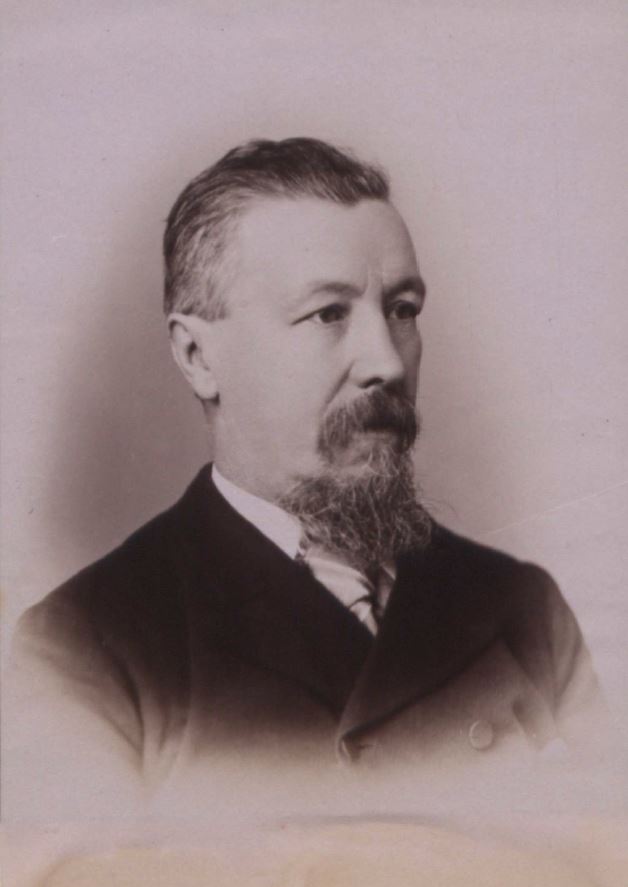
Edward Winter

J.H. Blackburne in January 1892 (see C.N. 9296 below)
The Art of the Checkmate by Renaud and Kahn has a reference to ‘James Harry Blackburne, 1842-1926’. This should read Joseph Henry Blackburne, 1841-1924.
(19)
As mentioned in an endnote on pages 264-265 of Chess Explorations, the mistakes came from the French original of Renaud and Kahn’s book. See too C.N. 9149, for a discussion of a ‘new 21st-Century Edition’ edition of the book, which has this:

C.N. 1052 recalled the occurrences of ‘James Harry’ Blackburne quoted in C.N.s 19 and 286, noting too the master’s obituary in the October 1924 Wiener Schachzeitung. In C.N. 1803 Brian Donnell (Portland, OR, USA) pointed out an early example of ‘James Harry’ Blackburne, on page 403 of von Gottschall’s Adolf Anderssen (published in 1912).
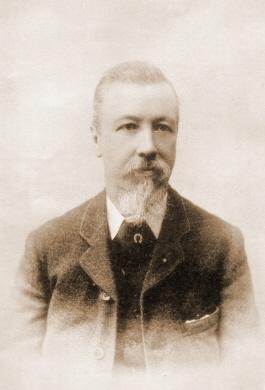
Mario Ziegler (Neunkirchen, Germany) queries the statement in our feature article Chess in 1924 that J.H. Blackburne was born in 1841, and not 1842:
‘I was very surprised to read this, because I had in mind Blackburne’s own information, on page 214 of Mr Blackburne’s Games at Chess, that he gave his first blindfold exhibition in 1862 at the age of 19.’
Blackburne’s year of birth used regularly to be given as 1842, but 1841 is correct. Below is an item in D.J. Morgan’s Quotes and Queries column on pages 180-181 of the June 1963 BCM:


The unfortunate misprints in the dates (1941, 1942, 1941 all being a century out) were corrected by D.J. Morgan in the following issue (July 1963, page 219). CHESS and the BCM seldom mentioned each other, but B.H. Wood’s magazine took the opportunity for a little sarcasm. From page 282 of CHESS, 29 June 1963:
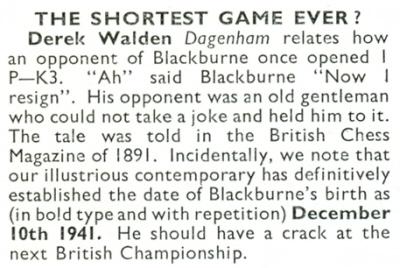
Page 1 of Mr Blackburne’s Games at Chess by P. Anderson Graham (London, 1899) stated:
‘He was born at Manchester on 10 December 1842 – the same year as that in which Staunton’s handbook was published ...’
This is doubly wrong, since the Handbook first appeared in 1847.
The Dover edition of the book, Blackburne’s Chess Games (New York, 1979), contained an Introduction by David Hooper which, on page vi, corrected the birth-date:
‘He was born on 10 December 1841, not 1842, as is stated at the beginning of Chapter I.’
See also the census information about Blackburne in C.N. 4756.
(5109)
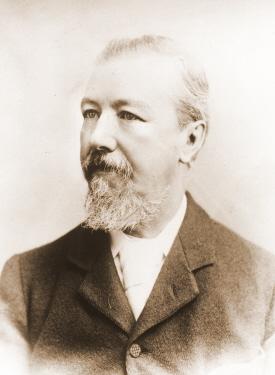
Where Did They Live? includes the following entries for Blackburne:
16 Lucey Road, London SE, England (Chess Amateur, October 1924, page 32 (address in 1879) and the 1881 British census (C.N. 4756)).
116 Barkworth Road, Camberwell, London, England (1891 British census (C.N. 4756).
7 Whitbread Road, Lewisham, London, England (1901 British census (C.N. 4756).
45 Sandrock Road, Lewisham, London SE, England (Ranneforths Schach-Kalender, 1915, page 56, and Hastings Chess Club address list, 1922).
As C.H.O’D. Alexander pointed out in The Penguin Book of Chess Positions, page 17, attacks on unoccupied squares can be difficult to see – even for experienced players. Here is a neat example of J.H. Blackburne finding a lovely knight move that leaves this piece open to capture three ways.
Joseph Henry Blackburne (simultaneous) – Amateur
Canterbury, 1903
Muzio Gambit
(Notes – and how characteristic they are – by Blackburne)
1 e4 e5 2 f4 exf4 (‘On this occasion, to follow the fashion, I offered the King’s Gambit wherever I had the chance; and to my utter astonishment, nearly all were accepted. “That’s the way to learn chess”, said I.’) 3 Nf3 g5 4 Bc4 g4 5 Bxf7+ (‘An almost obsolete variation. Some 40 years ago or more, I frequently played it, but came to the conclusion that it did not lead to such a lasting attack as the ordinary Muzio. When I sacrificed the bishop, one of the lookers-on asked what Gambit I called that, pointing to the next board. “That”, I said, “is the Bishop’s Gambit, and this is the Archbishop’s.” The Archbishop was present at the time.’) 5...Kxf7 6 Ne5+ Ke8 (‘The only move. Any other loses immediately.’) 7 Qxg4 Qf6 (‘The correct reply is 7...Nf6.’) 8 d4 Bh6 9 O-O Qg7 10 Qh5+ Ke7 11 Bxf4 Bxf4 12 Rxf4 Nf6 13 Qh4 d6 14 Nc3 c6 15 Raf1 Rf8
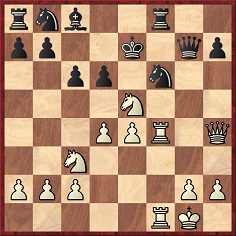
16 Nf7 (‘16 Nxc6+ would equally have won, but I could not resist this; it is the sort of move sure to intimidate the ordinary amateur. Anyway it somewhat non-plussed my opponent, for he immediately exclaimed, “What have you taken?”’) 16...Rxf7 17 e5 dxe5 18 dxe5 Nbd7 19 exf6+ Nxf6 20 Ne4 Be6 21 Nxf6 Kf8 22 Nxh7+ Kg8 23 Rxf7 Bxf7 24 Nf6+ Kf8 25 Qb4+ (‘How’s that, umpire?’) Resigns.
Source: BCM, September 1903, page 392.
(182)
Charles Dickens and Chess mentions that the game Piper v Davie was annotated on pages 394-396 of the December 1916 BCM with quotations from The Pickwick Papers.
We add that pages 119-120 of the May-June 1915 American Chess Bulletin reproduced from the Family Herald an article ‘Great Pickwickian Discovery’, comprising a game (J.H.B. v S. Pickwick) which also had annotations in the form of quotes from Dickens’ novel.
The game, not identified in the article, was Blackburne v N.N., Canterbury, 1903. We gave it in C.N. 182, with Blackburne’s notes from page 392 of the September 1903 BCM. See pages 31-32 of Chess Explorations.
(6937)
Annotating a game in the October 1904 issue of the BCM (page 406), Blackburne says of his first move, 1 c4:
‘I play this move not that I like it, but because my opponent likes it less.’
(183)
Edward Janusz (Bricktown, NJ, USA) draws attention to a comment by Blackburne on page 122 of his games collection:
‘The English was once looked upon as sound but is now practically discarded.’
Our correspondent adds that ‘English Opening’ at the time may have meant just the move 1 c4 (even with transpositions into various Queen’s Pawn openings), and not an ‘actual system’.
(1320)
Even J.H. Blackburne has been suggested as a possible precursor of hypermodern play. From page 207 of The Game of Chess by Harry Golombek (various editions):
‘His games, though so strongly influenced by Morphy, also curiously foreshadow the most modern developments. For example, as early [as] in 1883 at the great international tournament in London he was playing as Black the first three moves of Nimzowitsch’s Defence to the Queen’s Pawn, three years before the birth of Nimzowitsch; whilst his English opening at Ostend, 1907 was remarkably similar for some 12 moves to the system evolved many years later by Réti.’
That claim was mentioned in C.N. 283, and in C.N. 411 W.H. Cozens (Ilminster, England) gave his view on whether Blackburne’s games showed evidence of a system:
‘No, not at all. He was the most faithful exponent of the open game right to the last. Even in his last tournament (St Petersburg, 1914) he played 1 e4 most of the time. We tend to forget his sense of humour. When he sat down opposite Nimzowitsch one can almost see the twinkle in his eye as he opened 1 e3 d6 2 f4, etc. (and won). If anyone tried to be funny with him he played along. Gunsberg v Blackburne went 1 e3 g6, followed by ...Bg7, ...d6, ...e6, ...Ne7, ...O-O. Late in life, like other aged masters, he did not trust his own opening erudition against the youngsters (e.g. he met Marshall’s Q-Pawn with ...Nf6, ...c6, ...d6, ...Qc7). But to see a hypermodern system in all this is reading into it more than is there.’
On page 260 of Chess Explorations we added that the Blackburne games from Ostend, 1907 which Golombek appeared to have in mind were against E. Znosko-Borovsky, W. John and E. Cohn.
Information on chess book sales is rarely published. In a letter to the BCM (September 1932, page 402) John Keeble wrote:
‘In 1899 our much loved chess master, J.H. Blackburne, published his Games at Chess, selected, annotated and arranged by himself. This work was edited in an excellent way by P. Anderson Graham, and, I think, sold at ten shillings per copy. In August 1914 Mr Blackburne told me 3,001 copies of the book were printed, and up to that date 2,900 had been sold. The remainder were eventually disposed of, so that the book brought in £1,500, and must have made a profit.’
The author (‘S’) of an earlier BCM article then added to Keeble’s letter the consideration that the total royalties (presumably 10-15%) shared by Blackburne and Graham were thus not likely to have exceeded £150 or £225. In fact, the sums would have been smaller by one quarter; the selling price was 7/6 (BCM, December 1899, page 500).
(1538)
See also Chess Book Sales.
From Duplication of Chess Games:
Sometimes a master has the opportunity to play the identical game twice:
J.H. Blackburne – Two unnamed players
Hastings and Eastbourne, 1894
French Defence
1 e4 e6 2 d4 d5 3 Nc3 Nf6 4 Bg5 Be7 5 Bxf6 Bxf6 6 Nf3 O-O 7 Bd3 Nc6 8 e5 Be7 9 h4 f6 10 Ng5 fxg5 11 Bxh7+ Kxh7 12 hxg5+ Kg8 13 Rh8+ Kxh8 14 Qh5+ Kg8 15 g6 Rf5 16 Qh7+ Kf8 17 Qh8 mate.
On page 179 of Mr Blackburne’s Games at Chess J.H.B. wrote: ‘A curious fact about this game is that move for move I played it exactly in the same way twice in one week, once at Hastings and once at Eastbourne, in the year 1894.’
From our Stalemate feature article:
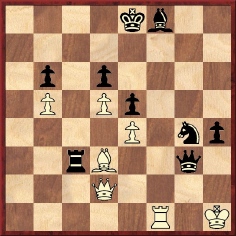
J.H. Blackburne -S. Winawer, Dresden, 26 July 1892 (Black to move)
Black played 49…Rxd3, which Blackburne answered with 50 Rxf8+, and the game was drawn. If 50…Kxf8 51 Qxh6+, and White will draw by stalemate.
Sources: Deutsche Schachzeitung, September 1892, pages 270-272 and the Dresden, 1892 tournament book, pages 167-169.
From page 90 of the December 1908 Chess Amateur:
‘Blackburne is always amusing, and must have his little joke. Referring to the bookworms, he said: “These players come with their favourite variations worked up in the Queen’s and the Petroff , and I play 1 P-K4. They reply 1...P-K4, thinking they are going to get their Petroff. Then I go on to 2 P-Q4 ; they promptly take it 2...PxP, and think they are going to get a Danish. I go to 3 Kt-KB3, and now they play 3...Kt-QB3, thinking they have at least got a Scotch. But when I continue 4 B-QKt5, they discover they have tumbled into one of the worst forms of the Ruy López, without being aware of it.”’
(1900)
A Blackburne brilliancy
A favourite Blackburne brilliancy from pages 182-183 of Mr Blackburne’s Games at Chess by P. Anderson Graham:
Joseph Henry Blackburne (simultaneous) – N.N.
Manchester
Steinitz Gambit
1 e4 e5 2 Nc3 Nc6 3 f4 exf4 4 d4 d5 5 Bxf4 dxe4 6 d5 Qf6 7 Qd2 Nce7 8 d6 Ng6 9 Nd5 Qxb2 10 Nxc7+ Kd8 11 Rd1 Rb8 12 d7 Bb4 13 Ne6+ fxe6 14 Bc7+ Kxc7 15 d8(Q)+ Kc6 16 Qd6+ Bxd6 17 Qxd6 mate.
No date is given, but the book’s chronological order suggests 1894 or 1895. In fact, the score had already been published much earlier in a number of sources, such as pages 44-45 of the 15 December 1886 issue of the Brooklyn Chess Chronicle and pages 171-172 of the Columbia Chess Chronicle of 2 June 1888; Black’s opponent was identified as H. Stelling, and the occasion indicated as a 22-board simultaneous exhibition in Manchester. Moreover, the conclusion was given as the less spectacular 14...Ke7 15 d8(Q)+ Resigns; the finish published in the Blackburne book is in the Columbia Chess Chronicle’s notes.
(2047)
Afterword:
The above miniature was given in C.N. 19, with notes from Social Chess by James Mason (London, 1900).
We are still seeking games with announced mates longer than the games themselves. The following, given on page 151 of P. Anderson Graham’s monograph on Blackburne, is a borderline case:
J.N. Burt – J.H. Blackburne (simultaneous)
Bristol, 1869
King’s Gambit Accepted
1 e4 e5 2 f4 exf4 3 Nf3 g5 4 Bc4 Bg7 5 c3 g4 6 Qb3 gxf3 7 Bxf7+ Kf8 8 Bxg8 Rxg8 9 O-O
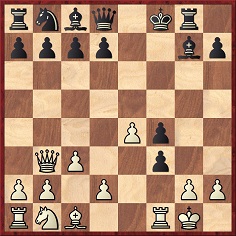
Here Blackburne announced mate in nine moves: 9...Bd4+ 10 Rf2 Rxg2+ 11 Kf1 Rxf2+ 12 Ke1 Rf1+ 13 Kxf1 Qh4 14 Qb4+ d6 15 Qxd6+ cxd6 16 cxd4 Bh3+ 17 Kg1 Qe1 mate.
(2166)
Richard Forster noted on page 10 of Kings, Commoners and Knaves:
‘The announcement is correct, but 13...Qh4? allows 14 cxd4 and White escapes immediate mate, though not defeat. The correct line is 13...Qg5!, i.e. 14 Qb4+ c5 15 Qxc5+ Bxc5 16 d4 Qg2+ 17 Ke1 Qe2 mate.’
For further information on this topic see Announced
Mates.
The game-score below, from a simultaneous display, appeared on page 154 of Schachjahrbuch 1914 I. Teil by L. Bachmann (Ansbach, 1914), but we wonder if it is correct, given that, at move 23, White could have forced mate with a standard queen sacrifice.
Joseph Henry Blackburne – E.S.
St Petersburg, 9 May 1914
Vienna Game
1 e4 e5 2 Nc3 Nf6 3 Bc4 Nc6 4 d3 Be7 5 f4 exf4 6 Bxf4 Na5 7 Nf3 Nxc4 8 dxc4 d6 9 O-O Bg4 10 Qe1 Nh5 11 Be3 O-O 12 Nd5 a6 13 Rd1 c6 14 Bb6 Qd7 15 Ne3 Bxf3 16 Rxf3 Qe6 17 Nf5 Rae8 18 Bd4 Nf6 19 Qg3 g6 20 Nxe7+ Qxe7 21 Bxf6 Qxe4 22 Qh3 Re6

23 Bc3 f6 24 Re1 Resigns.
(2562)
‘The only difference between amateurs and professionals at chess is that amateurs make more out of it.’
J.H. Blackburne, quoted on page 37 of the February 1915 BCM.
(Kingpin, 1997)
Blackburne, who seldom annotated games other than his own, provided notes to the following brilliancy on page 23 of the 28 February 1865 issue of the Household Chess Magazine:
James Stanley Kipping – Eduard Pindar
Occasion?
Evans Gambit Accepted
1 e4 e5 2 Nf3 Nc6 3 Bc4 Bc5 4 b4 Bxb4 5 c3 Ba5 6 Qb3 (‘This line of attack is, in our opinion, not so good as 6 d4.’) 6…Qe7 (‘6…Qf6 is the proper reply.’) 7 Ba3 d6 8 d4 exd4 9 O-O Nf6 (‘Enabling White to obtain a most powerful attack. 9…Nh6 or 9…Bb6 would have been better.’) 10 e5 Ne4 11 Re1 Nc5 12 Bxc5 (‘Here, we think, Mr Kipping scarcely made the most of his attack. He might have played, with advantage, 12 Bxf7+, when the following variation would be probable: 12 Bxf7+ Qxf7 (He can also play 12…Kd8 or 12…Kf8, but in either case White wins.) 13 exd6+ Kf8 14 Bxc5 Qxb3 (best) 15 d7+ Kf7 16 dxc8(Q) Qd5 17 Ng5+ Kg6 18 Qg4 and White must win.’) 12…dxc5 13 e6 f6 14 Nh4 g6 15 f4 O-O (‘This does not improve Black’s game; again, 15…Bb6 would have been preferable.’) 16 f5 g5 17 Nf3 Bb6 18 a4 Na5 19 Qa2 c6 (‘Why not take the bishop? That must have been his intention when he moved 18…Na5.’) 20 Nbd2 a6 21 Ne4 Ba7 22 cxd4 cxd4 23 Bd3 c5 24 Rac1 (‘The prelude to a most brilliant combination.’) 24…b6
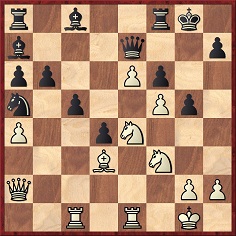
25 Nxd4 (‘From this point the game is very interesting and instructive.’) 25…cxd4 (‘Apparently unconscious of the coming danger.’) 26 Rc7 (‘A beautiful continuation. After this move Black has no resource.’) 26…Qxc7 27 e7+ Kg7 28 exf8(Q)+ Kxf8 29 Nxf6 Qf7 30 Re8+ Kg7 31 Nh5+ (‘The decisive move, and must have been foreseen by Mr Kipping when he sacrificed the knight on his 25th move.’) 31…Qxh5 32 Qg8+ Kf6 and White mates in two moves.
(Kingpin, 1998)
Concerning the note to White’s 31st move, on page 66 of A Chess Omnibus we mentioned that 30 Re8+ was not the only win for White.
Blackburne called the following game the most brilliant and interesting of all his losses in blindfold displays:
Joseph Henry Blackburne (blindfold) – George Beach
Macclesfield, 1900
Evans Gambit Accepted
1 e4 e5 2 Nf3 Nc6 3 Bc4 Bc5 4 b4 Bxb4 5 c3 Ba5 6 d4 exd4 7 O-O dxc3 8 e5 b5 9 Bxb5 c2 10 Qxc2 Nge7 11 Rd1 O-O 12 Nc3 Bb7 13 Ba3 Re8 14 Ng5 g6 15 Nce4 Nd5 16 Rxd5 Nxe5 17 Rxe5 Rxe5 18 Bb2 Rxg5 19 Nf6+
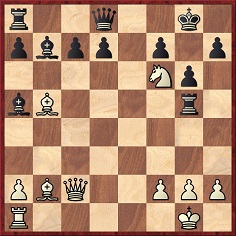
19…Qxf6 20 Bxf6 Rxg2+ 21 Kf1 Rxh2 22 Qb3 Rh1+ 23 Ke2 Re8+ 24 Kd3 Rh3+ 25 Kc2 Rxb3 26 axb3 Bb6 27 Bxd7 Re2+ 28 Kc3 Rxf2 29 White resigns.
Source: BCM, February 1937, page 100.
(2400)
We have been unable to find game-scores which fit in with the following report, taken from page 315 of the Chess Amateur, July 1908:
‘Referring to “hallucinations that occur in match and tournament play”, Mr Bruno Siegheim mentions in the Johannesburg Sunday Times that in one of the games of the Blackburne-Steinitz match, a check which could have won a rook was left on for several moves. The possibility was seen by everyone present in the room except the two players. Mr Siegheim adds that a still more curious incident occurred at Breslau, in an Alapin-Blackburne game. Mr Blackburne checkmated his opponent, but assuming that Herr Alapin would see the mate, Mr Blackburne did not announce it. Herr Alapin looked at the position intently, trying to find a move, and the spectators smiled and whispered. At the end of five minutes Mr Blackburne relieved his opponent’s anxiety by informing him that he had been checkmated.’
(2557)
‘Mr Blackburne contemplates issuing a collection of about 200 of his blindfold games in a volume. The price will probably be 2s.6d. Mr Wade, Chess Monthly Office, is to be the printer and publisher.’
Source: the Chess Monthly, March 1888, page 195.
The collection never appeared, and the only Blackburne volume published during his lifetime was the P. Anderson Graham collection of 1899.
(2728)
An endnote on page 264 of Chess Explorations reported that page 428 of Who Was Who 1916-1928 had an entry on P[eter] Anderson Graham (died 25 October 1925), a prolific author and sometime editor of Country Life. His recreations were listed as chess, billiards and golf.
Perusing his bookshelves, the bibliophile will sometimes find himself struggling to recall when and where various volumes were procured, and perhaps also why. In the ‘local history’ section of our library, for instance, we have just been re-reading Fifty Years of Chess at Battersea (published by the Battersea Chess Club, London in 1935) in the unavailing hope of finding an item or two to cull. Chess in Bedfordshire by F. Dickens and G.L. White (Leeds, 1933) looked rather more promising, but the games section is brief and we can do no better than quote the following forgotten score, taken from pages 65-66:
Joseph Henry Blackburne – James Gladwell
Simultaneous blindfold exhibition, Luton, 4 November 1880
Scotch Game
1 e4 e5 2 Nf3 Nc6 3 d4 exd4 4 Nxd4 Nxd4 5 Qxd4 c6 6 Nc3 b6 7 Bc4 h6 8 Bf4 Nf6 9 e5 Bc5 10 Qd2 Nh5 11 Ne4 Qe7 12 O-O-O Nxf4 13 Qxf4 O-O 14 Rd6 Bxd6 15 exd6 Qd8 16 Re1 a5 17 Re3 Ba6 18 Rg3 Kh8 19 Bxf7 Bc4
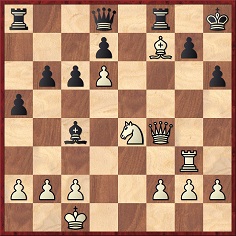
20 Ng5 Bxf7 21 Nxf7+ Rxf7 22 Qxf7 Qf6 23 Qxf6 gxf6 24 Rg6 Re8 25 Rxf6 Kg7 26 Rf3 Re6 27 Rd3 Kf6 28 Kd2 Ke5 29 Ke3 Rxd6 30 Rxd6 Kxd6 31 g4 Ke5 32 f4+ Kf6 33 h4 d6 34 Ke4 Resigns.
(2806)
From an article by J.H. Blackburne on pages 200-201 of the City of London Chess Magazine, August 1875:
‘Problem composers are frightful bores, and are fast becoming an intolerable nuisance. You cannot nowadays enter a chess room or club without some young and aspiring problemist persisting in showing you a position which he is pleased to call a problem. Though somewhat eccentric they are quite harmless and, moreover, exhibit an unusual amount of forbearance. After, for instance, solving their stupid position in fewer minutes than it has taken weeks to construct, saying that it is weak and obvious – mere rubbish, or words to that effect, telling them that it is a feeble imitation of J.B., a facsimile of Healey or some other well-known composer, strange to say, instead of knocking you down as any ordinary mortal would do, they, with a benevolent smile upon their face, offer you a cigar; and, still more remarkable, will take the first opportunity of setting up for your critical examination their latest and, as they usually fancy, the finest and most difficult problem extant. Such, at any rate, is our experience.’
(2968)
A game from pages 68-69 of Schaakkalender van het Noordelijk Schaakbond 1883:
M. – Joseph Henry Blackburne
Rotterdam, 30 June 1880
Ruy López
1 e4 e5 2 Nf3 Nc6 3 Bb5 Bc5 4 O-O Qe7 5 Nc3 Nf6 6 d3 h6 7 Bxc6 dxc6 8 d4 exd4 9 Nxd4 Bg4 10 f3 O-O-O 11 Be3 Bh5 12 Kh1 Qe5 13 f4 Qe8 14 Qd3 Bxd4 15 Bxd4 c5 16 e5 cxd4 17 Qf5+ Qe6 18 Qxe6+ fxe6 19 exf6 dxc3 20 fxg7 Rhg8 21 f5 cxb2 22 Rab1 exf5 23 Rxf5 Rd1+ 24 Rxd1 Bxd1
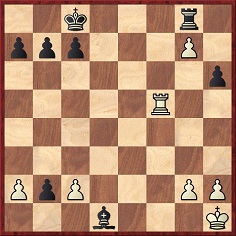
25 Rf8+ Kd7 26 Rxg8 b1(Q) 27 Rd8+ Kc6 28 h3 Bh5+ 29 Kh2 Bf7 30 Rf8 Qxa2 31 White resigns.
(2998)
See also Unknown Games, which has several encounters between Blackburne and Dupré.
Following Blackburne’s death, B.G. Laws wrote on page 402 of the October 1924 BCM:
‘The following incident was recorded by William Geary, who died last year.
Some time in the ’70s Blackburne was a patient at St Thomas’ Hospital, and on one occasion the dispenser said to him, ‘Are you Mr. Blackburne, the chessplayer?’ On being informed he was, Blackburne was asked if he could spare a few minutes for a chat. In the course of conversation relating to memory, Blackburne was asked if he thought he could repeat from memory a few of the abbreviated Latin names on the medicine bottles. After being given a few minutes to study them our chess master offered to test himself. With no knowledge of pharmaceutical Latin or medicine it is remarkable that he not only succeeded with three or four scores of names but expressed willingness to call them all out (back turned to the shelves, of course) either forward or backward. This is a wonderful feat of memory and as hinted above made more surprising as the names had no meaning to the performer.’
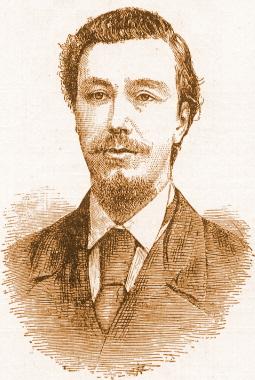
(3145)
See too Memory Feats of Chess Masters.
Steve Giddins recalls a paragraph concerning J.H. Blackburne in W.H. Cozens’ ‘Half a Century Back’ article on pages 387-393 of the November 1974 BCM:
‘Had he not preferred to give his whole time to play he might have been a considerable problemist. He did compose a number of three- and four-movers. He had no use for two-movers, except to demonstrate that he could solve them not merely at sight but blindfold. “Call the men out to me one at a time”, he used to say, “and don’t bother to give the black king.” When will England breed such another?’
Our correspondent asks whether contemporary accounts exist of Blackburne’s skill in the field of chess problems.
P. Anderson Graham’s 1899 book on Blackburne gave (on pages 317-326) 28 problems composed by the master between 1861 and 1894, and all but one of these were reproduced by John Keeble in an article about Blackburne as a problemist on pages 113-116 of the April 1910 issue of La Stratégie. Keeble provided more facts in a letter published on page 402 of the October 1924 BCM:
‘In common with all British chessplayers it was with great regret that I heard of the death of Mr J.H. Blackburne. Many able pens will no doubt write favourable biographical notices, but I am wondering if any will speak of his skill as a problemist. I have discussed this subject with him many times. Mr Blackburne composed many fine problems, 28 are to be found in his book, but he told me he must have composed at least 100, and only about 30 of these have been traced. Mr Blackburne said in his early days, 1861-2, he used to make about one problem a week. Many of these were published in the Manchester Express, under the initials R.S., but at that time he did not want to be a great chessplayer, or to be known as a composer of problems, so that when people began to inquire who R.S. was he altered the initials to anything that might occur to him at the time, but never to anything that would give a clue to his real name.
Mr Blackburne’s problems are all in three or more moves. He never published a two-mover, but once said he generally composed them as two-movers and afterwards added a move. Most of his problems do really appear to have been built up in that way.
Mr Blackburne held one peculiar view on chess. I showed him a problem in which PxP en passant occurred. He at once said he thought that when an International Chess Federation is formed, one of their first acts will be to abolish PxP en passant from the game of chess, and I think he meant it, for in later years he adhered to that view.’
The same issue of the BCM (page 435) had the following tribute to Blackburne in the problem section conducted by B.G. Laws and G.W. Chandler:
‘Many to whom the name of Blackburne is almost a spell are not aware that he was in his early career the composer of some excellent problems judged by the standard of construction then prevailing. We do not remember having seen a specimen by him of a two-mover, but we know he regarded them with more or less disdain. Only on one occasion we believe did he compete in a problem tourney and that was in the congress of the British Chess Association, 1862. A singular thing happened with a four-mover of his set which was passed as sound by the committee of judges. It was not until 1895 that we discovered it had a second solution, much to Blackburne’s surprise. As a solver he was very quick. He often amused a mixed company by solving two-movers with lightning speed, stipulating that the position be set up without the black king. This is of course not a great feat in the case of experienced solvers and composers, but it was made more surprising when he did this sans voir, having the position called out to him man by man in any chance order.’
A feature entitled ‘J.H. Blackburne as a composer’ appeared on page 267 of the June 1899 BCM. Below is an extract:
‘We are not in a position to say how many specimens have been manipulated by his imaginative brain, but this we can say – that such positions as we have seen all illustrate something worth the trouble of unravelling. As a rule, difficulty has proved to be an important element in his compositions, and we believe Mr Blackburne is strongly in favour of this feature in chess problems so long, of course, as it does not obliterate a pronounced chess conceit or “a bit of Morphy”. The eminent player’s efforts are not of recent date, and must not be criticized too severely, and too harsh a comparison made with models of the modern art …
As a solver it may be well to state that very few expert solvers excel Mr Blackburne’s ability to “touch bottom” of the most abstruse stratagem. His perception is keen and his quickness almost phenomenal, regard being had to the fact that problem-solving is not treated by him as a serious matter.’
In an article on chess problems which Blackburne contributed to the Strand Magazine, March 1908, pages 174-178, the beauty and practical relevance of problems were stressed:
‘There are among the votaries of the royal game many who believe that problems contain the very highest form of chess, and look upon them as works of art – as much a creation as a painting, poem or musical composition.
The mere player who has never experienced the magnetic attraction of problems cannot fully realize the feeling of joy and satisfaction from solving some masterpiece, the work of a famous composer.
There can be no doubt that solving problems, especially from diagrams, is an intellectual amusement, and that the study of problems tends to accuracy of analysis, quickens the perception and strengthens the chess faculties generally, and may occasionally impart some of those sparkling ideas which are so sadly needed in ordinary play.’
An example of Blackburne’s output (a three-mover composed in 1876) is given below:
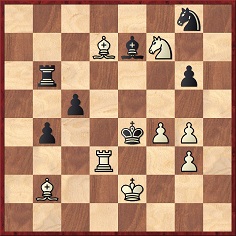
(3261)
An eminent figure with an interest in chess was the physicist Sir Oliver Lodge (1851-1940). From page 249 of his autobiography Past Years (London, 1931):
‘Sometimes we had a fit of chess. I once played the twentieth part of old Blackburn [sic], and once took part in a tournament [sic] against that inspired youth Capablanca.’
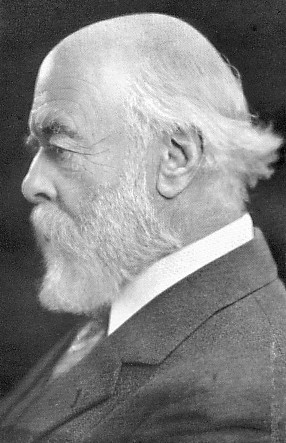
We are not aware that these games have been preserved and would welcome information about any mentions of the scientist in contemporary chess literature.
(3418)
A little information about Capablanca is available.
From Rick Kennedy (Columbus, OH, USA):
‘The opening 1 e4 e5 2 Nf3 Nc6 3 Bc4 Nd4 has been called the Blackburne Shilling Gambit, in recognition, apparently, of J.H. Blackburne’s use of it to win small stakes from players. However, I have yet to find a single game with it played by Blackburne. In fact, the earliest game uncovered was played in New Zealand in 1911. How did Blackburne’s name become attached to the variation? Indeed, when did it become attached?
Steinitz’s Modern Chess Instructor has a note on the line, but does not refer to Blackburne. Mr Blackburne’s Games at Chess makes no mention of it. Nor does Freeborough and Ranken’s Chess Openings Ancient and Modern attribute the line (given in a footnote) to anyone. E.E. Cunnington’s books (one on traps, one on openings for beginners), which were published in London shortly after the turn of the century, give the moves but do not name Blackburne.
One clue may be that the first edition of Hooper and Whyld’s Oxford Companion to Chess (1984) does not call the line by name, but the second edition (1992) calls it the Blackburne Shilling Gambit. Did the co-authors discover some historical information during that eight-year period?’
(3786)
From page 429 of the December 1897 American Chess Magazine:
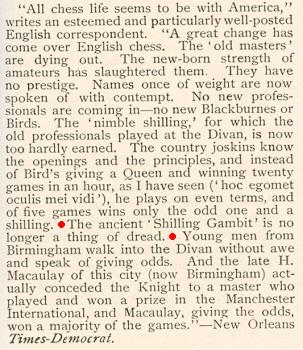
(6470)
See too C.N.s 6470, 6479, 7737 and 7804.
The above was the heading of an item on page 209 of the October-November 1899 American Chess Magazine:
‘Few people know, says M.A.P. in the Glasgow Herald, “that Mr Blackburne, who has once more vindicated his title as the first of English chessplayers, was in earlier life a worker in stone, and that the premises of the Law Life Assurance Society, adjoining the Church of St Dunstan’s-in-the-West, Fleet Street [London] show practical evidences of his skill in that craft”.’
Wanted, as ever, in such cases: corroboration and complementary information.
(3291)
Charles Platt wrote Chess: Draughts: How to enjoy them (London, 1933, and a slightly amended edition in 1941). Pages 53-57 had an example of his play, from a six-game blindfold display by Blackburne:
Joseph Henry Blackburne – Charles Platt
Occasion?
Center Counter-Game
1 e4 d5 2 d4 dxe4 3 Nc3 Nf6 (‘In this game White knew my fondness for the Counter Gambit, so he played this variation, instead of taking the pawn as usual. It is known as the “Blackman [sic] Gambit”, and is not often seen’ – Platt.) 4 Bg5 Bf5 5 Bc4 Nbd7 6 Nge2 Bg4 7 h3 Bxe2 8 Qxe2 Nb6 9 Bxf6 Nxc4 10 Qxc4 exf6 11 Nxe4 Be7 12 O-O-O O-O 13 g4 c6 14 Rhe1 Re8 15 Re2 Qc7 16 Rde1 Red8 17 c3 Bf8 18 Kb1 b5 19 Qb3 a5 20 Qc2 b4 (‘Black has the best of the game now, as White’s centre is weak and his rooks out of play for the moment. It ended in a draw, however, owing to White’s superior skill and experience in the endgame’ – Platt.)
It may seem paradoxical for doubled rooks on the e-file to be described as ‘out of play’.
(3504)
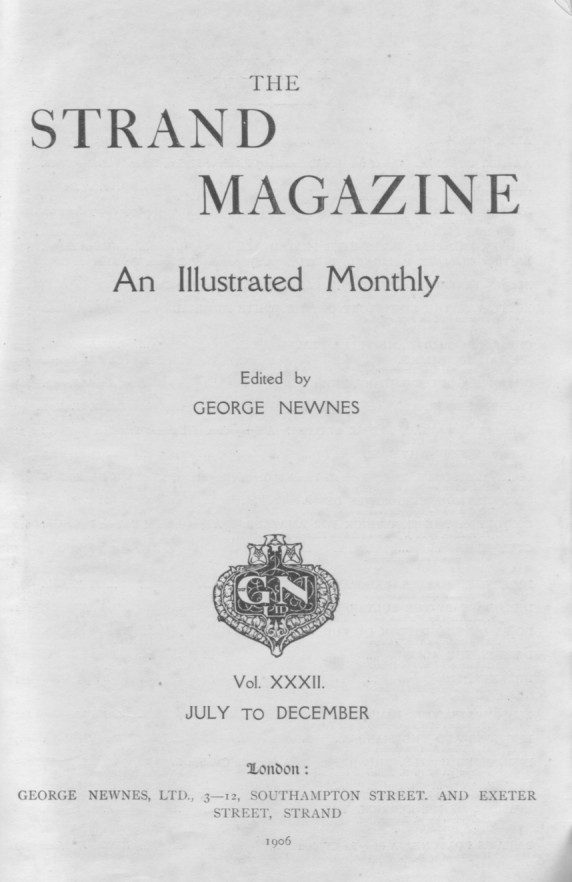
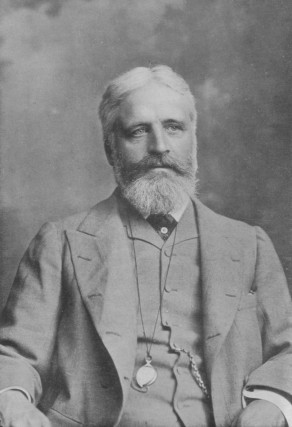
The Strand Magazine, the monthly periodical of the chess patron Sir George Newnes, Bart. (pictured above), seldom had articles on chess, but one such was published on pages 722-725 of the December 1906 issue:
‘The Best Games Ever Played at Chess by J.H. Blackburne, British Chess Champion [sic]
Brilliancy in chess is a rarity. It is like the sparkling of a multi-faceted diamond, which can illume darkness and shine best under provocation. Electricians would say it is the bright spark that signalizes the overcoming of resistance. It is not a very common or ordinary experience. It would cease to be a wonder if it were. It would fail to command the great admiration usually bestowed on things of rarity.
The best quality of brilliancy occurs between great contending forces – the powers of antagonistic minds. And so it is that, generally speaking, the highest products issue from conflict wherein very great players are engaged – players accustomed to exert very strong powers of mind against their adversaries. There is then the pressure of strong and skilful opposition provoking strong display, until at length out flashes the brilliancy which thrills the spectators as well as the producer, and sometimes has almost a benumbing effect upon the vanquished player.
Brilliancy in actual play very often prevails in spite of a flaw – the dazzling effect, as it were, rendering the flaw invisible.
Sound or flawless brilliancy in chess is the brilliancy that deserves the fullest consideration. The production of it sheds lustre on the happy producer, while it also serves a high educational function in giving us something to admire and study.
The alternation of stroke or “move”, combined with the necessity of parrying as well as delivering the stroke, has brought about in chess a practice of adopting aggresso-defensive tactics. It has developed an even higher ideal. It has led to the adoption, wherever possible, of a doubly attacking move – such as that of a knight forking two of the adverse pieces, or that of a bishop attacking or pinning on the one diagonal two or more of the opposing pieces. And, better still, it has led to the adoption, wherever possible, of such forking or raking moves as will include a check, or double check, to the adverse king; and, higher still, a move which, under every conceivable circumstance, will enable the player next moving to adopt one of these many-purpose moves.
It is chiefly in pursuit of some of these advantageous moves that brilliancy occurs. It may occur as a means of withdrawing, or paralyzing, or obstructing some of the hostile pieces, so as to get them out of the way or nullify their action, or make them embarrass their own king’s mobility. Design is the prolific source of ingenious brilliancy; yet, in a minor degree, luck contributes to the production. Some of these observations can be tested in examining the sample games appended.
Meanwhile a few words as to famous exponents of brilliancy in the past.
First and foremost comes the immortal Morphy, who in 1858 came over from America and overwhelmed all the European masters, or, at least, those who cared to oppose him. His games were splendid specimens of brilliancy; and probably many of his sparkling gems will be reproduced, studied, and admired when the efforts of the so-called “position player” and the “accumulator of minute advantages” school have been forgotten. Then there was Labourdonnais, the renowned French expert, who also vanquished all-comers; and what chessplayer has not received pleasure and instruction in playing over the games of Professor Anderssen and his illustrious pupil, Dr Zukertort?
Then, again, there was Captain Mackenzie, a Scot by birth, an enthusiastic disciple of Morphy, and who became champion of America after that master’s retirement.
De Vere, at one time British chess champion; the two Macdonnells, both Irishmen; Pillsbury, and Baron Kolisch were all worthy exemplars of brilliancy.
And last, though not least, the young Hungarian, Charousek, who a few years ago startled the chess world by his aggressive and hazardous play against older and more experienced masters, and justly earned the title of the “New Morphy”; and, considering his short chess career, has left us wondering what he might not have attained had he lived.
To living masters like Bird, Maróczy, Marshall, Janowsky and Chigorin, it is hard to do justice without seeming to indulge in flattery; yet it is not possible to omit them and give anything like a true account of chess brilliancy. We have in England for nearly two-thirds of a century enjoyed the splendid style of Mr H.E. Bird, especially notable for his originality. He may by his devotion to brilliancy have several times missed the chess crown. He has always apparently set less value on that than on the achievement of some brilliant mate. The same may be said of Chigorin, the famous Russian player. Marshall and Janowsky have given us many pieces of rich brilliancy, and Maróczy for his time has pretty well earned a title to brilliancy. But for him the future has still much in store.
Brilliancy does not appear to be on the wane. The new school (as a fresher one than the “modern”) is distinctly endued with love of adventure and brilliancy. The younger players, under its healthy influence, are able, when taking part in tournament play, to infuse life and brilliancy into their games and suffer nothing as a penalty for rashness. It is a good sign, and possibly portends further improvement in this direction.
I will now proceed to consider three games which stand on record as perhaps the most brilliant in the annals of chess.’
The three were Anderssen’s Immortal Game (‘This is considered by many to be the most beautiful ending ever played’), Zukertort v Blackburne at London, 1883 and Morphy’s ‘brilliant little gem’ against the Duke and Count at the Paris Opera.
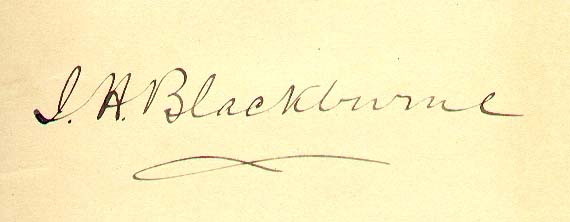
(3851)
We seek nineteenth-century occurrences of the terms ‘world champion’ and ‘world championship’ in the context of tournament play. The examples below come from The Knights and Kings of Chess by G.A. MacDonnell (London, 1894):
Page 7, regarding J.H. Blackburne: ‘But as a tourneyist he is supreme. Multitudinous have been his victories in international contests, and at Berlin, in 1881, he won the championship of the world.’ A footnote after the first sentence reads: ‘Written about three years ago.’
Pages 10-11: ‘In 1881, Blackburne won the first prize at Berlin, together with the Championship of the World.’
Page 31, in the section on G.H. Mackenzie: ‘The above sketch was written in 1887, just after Mackenzie had won the Chess Championship of the World.’
Page 78, on Gunsberg: ‘In all the great contests since then he has taken part and maintained his reputation as a very first-class tourneyist; whilst by his victory at Bradford Place [sic] in 1888, he surpassed all his previous performances and won a place among the champions of the world. Nor have his latest performances been unworthy of his championship, for he drew a long match with Chigorin and made the good score of 4 to 6 against Steinitz.’
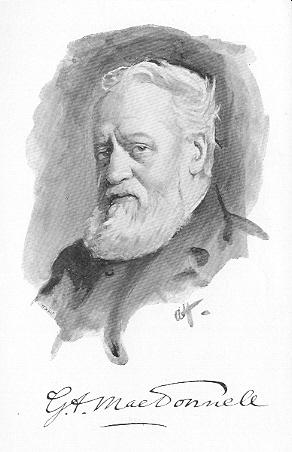
Rev. George Alcock MacDonnell
(3968)
‘Blindfold champion of the world’
How many players have been given, or have given themselves, the title ‘blindfold world champion’? Below are two cases which we have noted recently:
1. Opposite page 74 of the London Chess Fortnightly, 14 January 1893 was a photograph of ‘J.H. Blackburne, Blindfold Champion of the World’.
2. Page 241 of CHESS, July 1946 had an article entitled ‘My Sixth US Tour’ by George Koltanowski (‘World’s blindfold chess champion’).
(4396)
Addition on 6 September 2024:


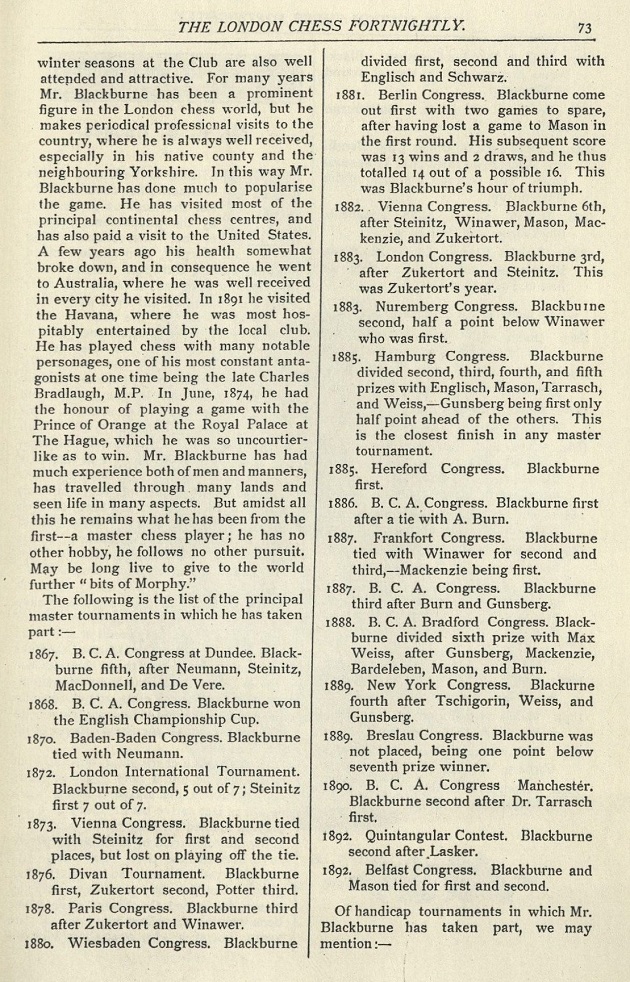

The above scans have been provided by the Cleveland Public Library.
See also Blindfold Chess.
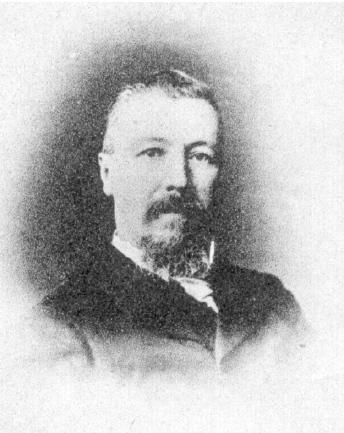
From a six-board blindfold display:
Joseph Henry Blackburne (blindfold) – Kemp1 e4 e5 2 Nf3 Nc6 3 d4 Nxd4 4 Nxd4 exd4 5 Qxd4 d6 6 Nc3 c6 7 Bf4 Be6 8 O-O-O Qb6 9 Qd2 Rd8 10 a3 Be7 11 Be3 Qa5 12 Nb1 Qc7 13 Bd3 Nf6 14 h3 Nd7 15 f4 Nc5 16 Bxc5 dxc5 17 Qe3 h6 18 e5 O-O 19 Nd2 Rde8 20 g4 f6 21 Qe4 f5 22 Qe3 fxg4 23 hxg4 c4 24 Bg6 Rd8 25 f5 Bg5
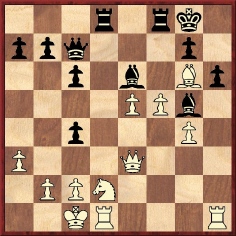
26 Qxg5 hxg5 27 Rh5 Qxe5 28 Rdh1 Qe1+ 29 Rxe1 Resigns.
The game was given on page 130 of the Chess Review, March 1893, with notes from the Glasgow Herald. The annotation regarding Black’s 27th move did not mention the possibility of 27...Bd5 but stated: ‘Making the game hopeless for Black. Black’s best move, as pointed out by Mr Crum, was RxBP.’
(4744)
Joost van Winsen (Silvolde, the Netherlands) offers details regarding Blackburne [as well as Gunsberg, Hoffer and Steinitz] from the records in British censuses:
1871 census: entry not found.
1881 census: Joseph H. Blackburne. Age: 39. Born in Manchester. Address: 16 Lucey Road, Bermondsey, London. Occupation: Teacher of chess. Married to Mary J. Blackburne (age 40). Children: Julius Blackburne (son, age 4). Shared the address with the Goodway family.
1891 census: J.H. Blackburne not found, although his wife is listed: Mary J. Blackburne. Age 50. Born in Rugby. Address: 116 Barkworth Road, Camberwell, London. Occupation: “Depends on husband at sea.” Children: Charles T. Blackburne (son, age 24), Florence S. Blackburne (daughter, age 19), Frederick W. Blackburne (son, age 9), Julius Blackburne (son, age 14), Lauretta J. Blackburne (daughter, age 26), Leonard W. Blackburne (son, age 22).
1901 census: Joseph Henry Blackburn [sic], age 58. Born in Manchester. Address: 7 Whitbread Road, Lewisham, London. Occupation: Professor of chess. Married to Mary Jane Blackburn [sic] (age 59). Child: Frederick William Blackburn [sic] (son, age 19). Two visitors were members of the household: Florence Sarah Evans (age 29) and Quinnie Florence Evans (age 3).
(4756)
We are grateful to Michael Clapham (Ipswich, England) for permission to reproduce this photograph from his collection:
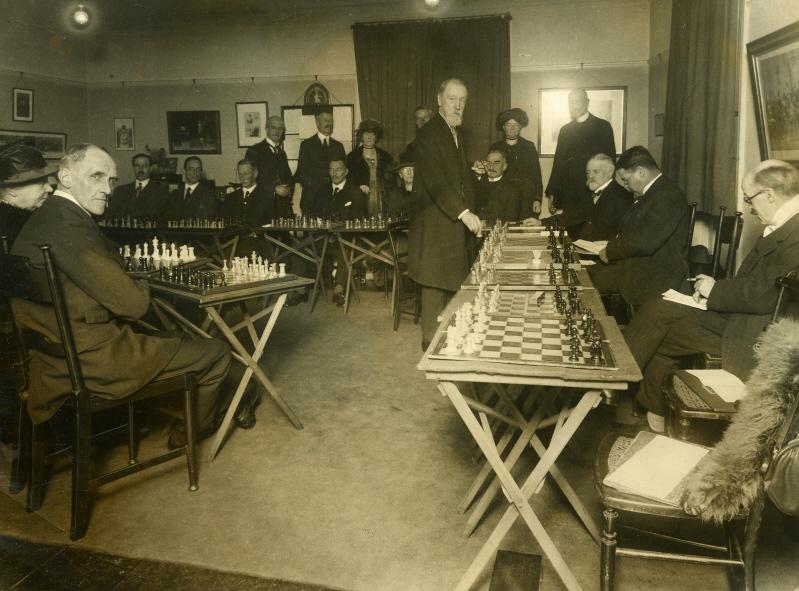
Our correspondent mentions that the picture was taken at the Imperial Chess Club in London. Below is the report of the occasion from page 25 of the January 1922 BCM:
‘There was an excellent attendance at the Imperial Chess Club, on Saturday, 17 December, to see our octogenarian “G.O.M.” play 20 games simultaneously against the members of the club. After five hours’ play the veteran had won nine, lost one to Mrs Banting, and ten games were drawn. His cheery remarks and audible asides were as amusing as ever. It was a wonderful performance for a man over fourscore years.’
(4791)
A slightly different shot from page 20 of the 18 December 1921 edition of the Sunday Illustrated (the London publication of Horatio Bottomley, the Independent MP for Hackney South):
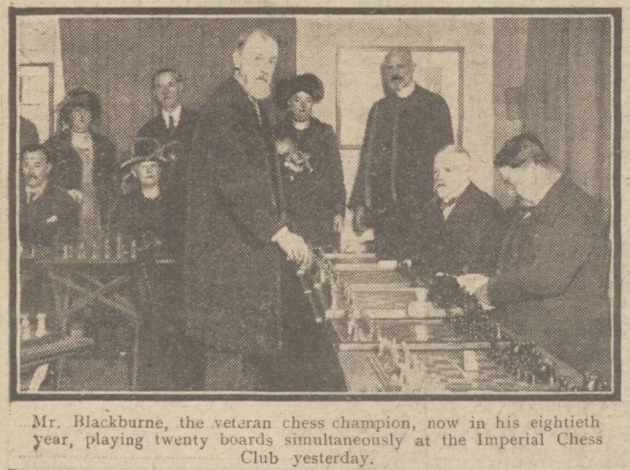
(11886)
Christophe Bouton (Paris) asks what factual basis exists for the very high estimates (of even 100,000 or more) for the number of games played by J.H. Blackburne.
The matter was addressed on pages 11-12 of Mr Blackburne’s Games at Chess by P. Anderson Graham (London, 1899):
‘He calculates that since 1861 he has played no fewer than 50,000 games at chess, and I think the estimate is probably under rather than over the real figure. A brief calculation will show my reason for so believing. He goes off on his chief tour early in October and does not return till Christmas, beginning another early in January. During the autumn of 1898 – and it was no exceptional season – he played close on 1,100 games. [Anderson Graham then gave detailed figures for January 1889 and continued as below.]
In one week, therefore, he played 117 games in public, of which eight were blindfold.
Between 1 October and 25 December he, as a rule, has played from 1,000 to 1,100 games. January and February are equally busy, and during the succeeding months his engagements are irregular, so that it is a fair estimate that he has been in the habit of playing at least 2,000 games a year. If allowance be made for the few seasons during which illness or some other cause kept him at home, it will be seen that his estimate of the total cannot be very far out.’

As regards the atmosphere of Blackburne’s displays, the following comes from page 286 of the July 1899 BCM:
‘Some simultaneous players pace from board to board as if engaged in a matter of life and death importance, and with a very serious – not to say sombre – funeral appearance. Not so Blackburne, for he contrives to make it a merry performance. He bubbles over with humour, he has flashes of fancy and plays off wit. He annotates each move as he goes along, and the annotations are calculated to make even the losing player laugh and be on good terms with himself. The player loses his game but does not lose his self respect; and this is important at chess. Blackburne has a delicate way of dealing with his opponents in simultaneous performances, and is not without a warm corner of estimation even for the despised “wood-shifter”.’
(4815)
The photograph below appeared opposite the first page of the January 1898 BCM:

(4037)
See our feature article Chess and Woodshifting.
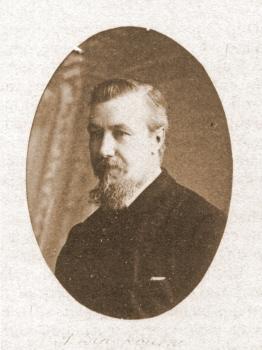
The following paragraph appeared on page 248 of Lasker’s Chess Magazine, April 1905:
‘The Cheltenham Chronicle is authority for the remark that once upon a time Blackburne was playing a simultaneous series in one of the English chess clubs and upon his opponent replying to his P-K4 with P-K3 he tried to be facetious and said, “Ha, I resign”. The player promptly replied, “Thank you, Mr Blackburne, I accept. Mr Secretary, will you kindly score a win for me.” And the game was so scored.’
We recall that an earlier version of the yarn was different. From page 232 of the May 1891 BCM, in an article on Purssells, London (‘one of the greatest chess rooms in the world’):
‘Blackburne was once playing here with a very irascible old gentleman, who was most particular in enforcing all rules of the game and, when in a certain humour, could not take a joke. It was his own first move, and he played P-K3. “Ah”, said Blackburne, “now I resign.” “All right”, said his touchy opponent, “that’s one game to me”, and nothing, as Blackburne knew, would alter that determination, so it was duly scored. This is the shortest game on record. Blackburne was beaten in one move.’
(4963)
C.N. 3195 (see Chess with Violence) commented that ‘promptly’ is a favourite word of the anecdotally inclined.
Blackburne offered his views in an interview with The Standard, from which the August 1910 BCM (page 338) printed an excerpt:
‘I think Zukertort was the best for a short time; but he fell off in a few years through ill-health. Steinitz was considered the strongest player, because he beat Zukertort in a match in the London Tournament of 1883. I played Zukertort in 1887, and beat him, but he was not himself at that time. The present champion, Dr Lasker, beat Steinitz ... in the last match Steinitz ever played. I think Dr Lasker is as good as Steinitz ever was in his best days. At the present time he is undoubtedly champion of the world. Morphy ..., in my opinion, would have been superior to Lasker or any champions of the modern school. He was my ideal of a chessplayer, and one of the greatest players, I think, who ever lived.’
An attempt is made here to progress with an unresolved matter from page 201 of Kings, Commoners and Knaves, and we therefore begin by quoting in full the relevant part of our text:
Middle-game combinations can also be the subject of duplication, but here too one must be wary, since chess chroniclers often write n’importe quoi. On page 39 of the March 1992 Europe Echecs, Sylvain Zinser asserted that the following position had arisen in ‘Blackburne v Gifford, England 1874’:
The finish is given as 1 Qxc6+ Kxc6 2 Ne5+ Kc5 3 Nd3+ Kd4 4 Kd2, and mate next move by 5 c3 is unavoidable. But this position bears an uncanny resemblance to the following, widely published in chess literature:
Kasparyan v Manvelyan, simultaneous display, USSR, 1936. White won with 1 Rxc6 Bxc6 2 Qc4+ Kb7 3 Qxc6+ Kxc6 4 Ne5+ Kc5 5 Nd3+ Kd4 6 Kd2 Qe6 7 c3 mate.
The question is why Zinser (and only Zinser, to our present knowledge) ascribed the 1 Qxc6+ combination to Blackburne, and now we may have the makings of an explanation. Below are pages 98-99 of The Middle Game in Chess by Reuben Fine (New York, 1952):
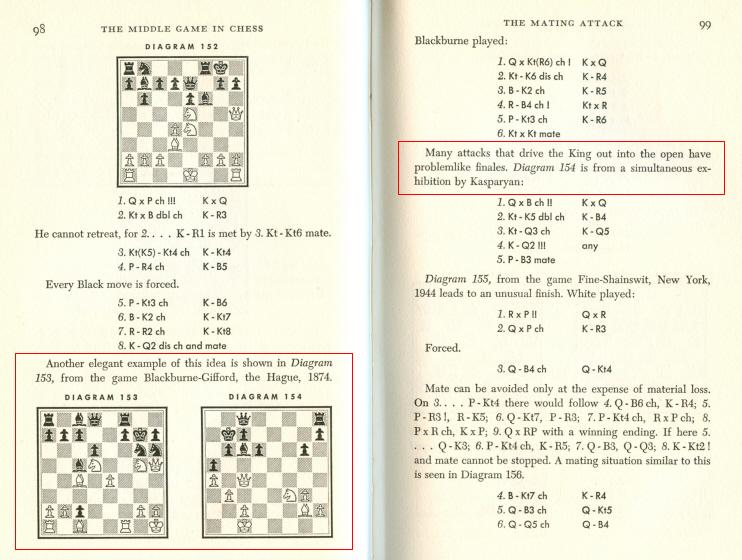
The Blackburne and Kasparyan positions are presented by Fine side by side, which may have resulted in his reference to ‘Blackburne-Gifford’ being misread as relating to diagram 154, instead of 153.
That still leaves two discrepancies, however. Firstly, whereas Fine stated that the game was played in the Hague (which is confirmed by, inter alia, page 154 of P. Anderson Graham’s book on Blackburne), Zinser placed the game in England. Secondly, Black’s king’s-side units in Fine’s diagram are omitted by Zinser. It is, of course, possible that these divergences were introduced elsewhere by another writer (i.e. after Fine and before Zinser).
We still lack definitive information about the Kasparyan position, which has been published over the years with varying details, though never, it seems, with the full game-score. Is a good, solid source from the 1930s available?
(5155)
Biographical information on H. Gifford is scarce. He was a participant in, for instance, the Paris, 1878 tournament and appears in the group photograph on page 38 of A Picture History of Chess by Fred Wilson (New York, 1981). Below is another of his games against Blackburne. It was played at Simpson’s Divan and is culled from page 153 of the Brooklyn Chess Chronicle, 15 July 1887:
H. Gifford – Joseph Henry Blackburne
London, summer 1886
King’s Gambit Accepted
1 e4 e5 2 f4 exf4 3 Bc4 b5 4 Bxb5 Qh4+ 5 Kf1 f5 6 Qe2 Nf6 7 exf5+ Be7 8 Nc3 Bb7 9 Nf3 Qh5 10 d3 O-O 11 Bc4+ d5 12 Bb3 Bd6 13 Qe6+ Kh8 14 Nxd5 Nbd7 15 Nxf6 Nxf6 16 Qe2 Nd5 17 Bxd5 Bxd5 18 Bd2 Bc5 19 Re1 Qxf5 20 Qe5 Qd7 21 h4 Rae8 22 Qc3 Be3 23 Rh3 Qg4 24 Re2 Bxf3 25 Rxf3 Qxh4 26 Rh3
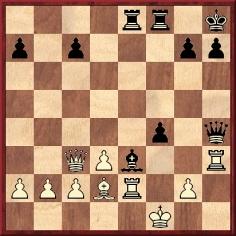
26...f3 27 Rxh4 fxe2+ 28 Kxe2 Bd4+ 29 Re4 Rf2+ 30 Ke1 Rxe4+ 31 dxe4 Bxc3 32 Bxc3 Rxg2 33 White resigns.
(5156)
Christian Sánchez (Rosario, Argentina) mentions that the ‘Kasparyan position’ discussed in C.N. 5155 was (after R. Fine and before S. Zinser) attributed to Blackburne v Gifford by L. Pachman:
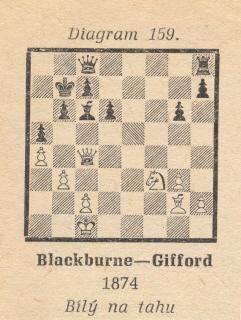
The above is reproduced from volume two of Taktika Moderního Šachu by L. Pachman (Prague, 1964). See also page 76 of the German edition (Moderne Schachtaktik, volume two) and page 64 of the Spanish translation (Táctica moderna en ajedrez, volume two), as well as page 49 of Attack and Defence in Modern Chess Tactics (London, 1973).
Biographical details about Gifford are still being sought. A rare instance of his being named as ‘Birkmyre Gifford’ occurred on page 109 of the April-May 1879 issue of La Stratégie.
(5163)
Peter de Jong (De Meern, the Netherlands) reports that there are several references to H.W.B. Gifford in 150 jaar DD (The Hague, 2005), and particularly on pages 29-31, in an article by S.Th. Hogers and W.J.P. Vink. Gifford, an Englishman, was a member of the DD (Discendo Discimus). He won the first unofficial Dutch championship, in the Hague in 1873, moved to Paris in 1877 and, as mentioned in C.N. 5156, participated in the following year’s tournament there (defeating Anderssen). The book also notes that Gifford was a composer. His birth and death details have yet to be established.
(5180)
Christian Sánchez notes that the Kasparyan position was published as ‘Kasparyan-Manvelyan’ on page 231 of Chess Review, November 1939. Can earlier appearances be found?
(5193)
A well-known miniature from page 154 of Mr Blackburne’s Games at Chess by P. Anderson Graham (London, 1899):
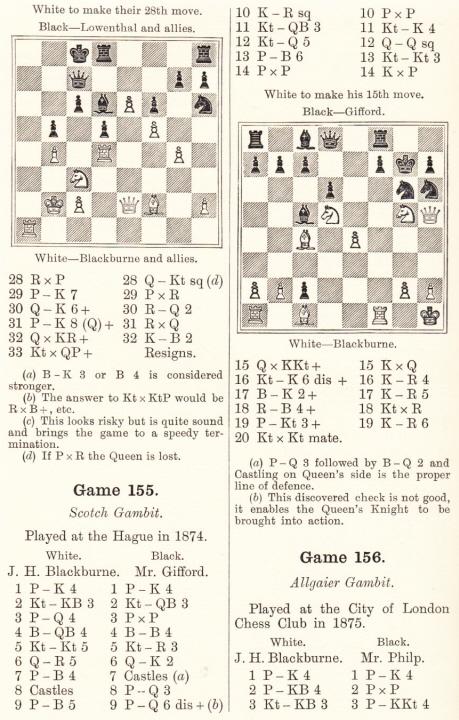
We note, though, that when Steinitz annotated the ‘beautiful little off-hand game’ in The Field, 25 July 1874 he gave a different finish:
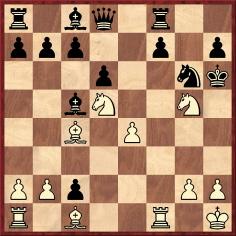
16 Nxf7+ Kh5 ‘White announced mate in five moves, viz.: 17 Be2+ Kh4 18 g3+ Kh3 19 Nf4+ Nxf4 20 Rxf4, and mates next move by 21 Bf1’.
That version was also on page 70 of Chess Sparks by J.H. Ellis (London, 1895) and on page 235 of the June 1898 BCM. Wanted: other pre-1899 appearances of the game in print.
(8217)
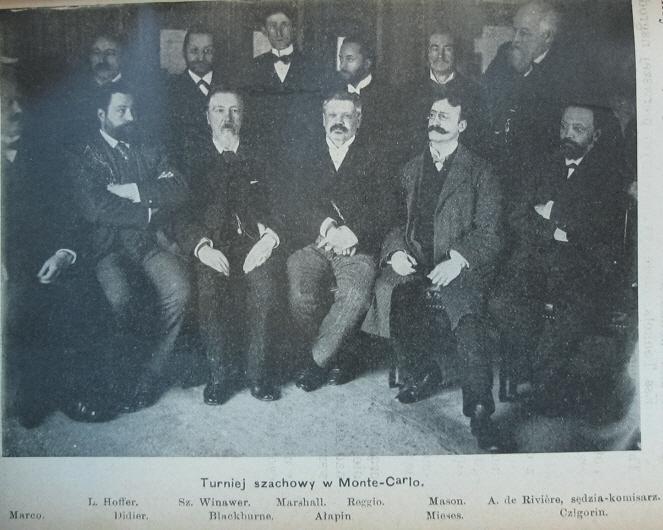
Tomasz Lissowski (Warsaw) submits the above group photograph of Monte Carlo, 1901, published in that year’s Sport, a Polish weekly periodical. He asks whether a copy of better quality can be obtained.
(5305)
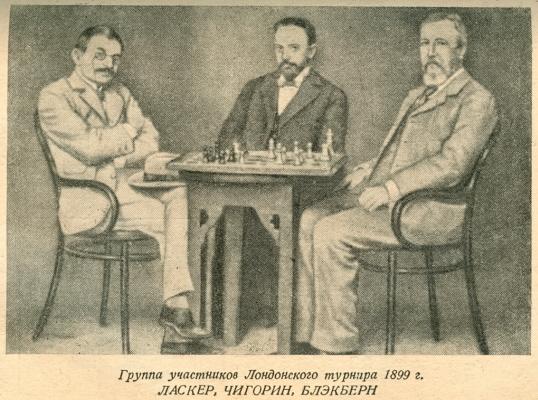
This picture comes from page 113 of N.I. Grekov’s 1952 monograph in Russian on Chigorin. Does any reader have a copy of better quality?
(5509)
Joost van Winsen writes:
‘Immediately after returning from Europe to New York G.H. Mackenzie published the following item in the Turf, Field and Farm (18 October 1878), stating that a game of his against Blackburne had been misprinted in a number of publications:
The game can be found in, for instance, the Illustrated London News of 27 July 1878, the Westminster Papers of August 1878 (pages 83-84) and the Paris, 1878 tournament book (pages 61-63), all with, at move ten, ...
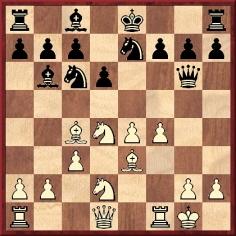
... a different move sequence: 10...f6 11 Rf3 Nxd4 12 cxd4 f5.
After giving Black’s tenth move as 10...f6, William N. Potter wrote in the Westminster Papers:
“If the score be correct, this is an outrageous b[l]under. And were it otherwise, I cannot see any merit in the move.”’
Below is the complete game-score as presented by Mackenzie (with no opportunity for White to win outright by 11 f5):
Joseph Henry Blackburne – George Henry Mackenzie
Paris, 1 July 1878
Scotch Game
1 e4 e5 2 Nf3 Nc6 3 d4 exd4 4 Nxd4 Bc5 5 Be3 Qf6 6 c3 Nge7 7 Bc4 d6 8 f4 Bb6 9 O-O Qg6 10 Nd2 f5 11 Rf3 Nxd4 12 cxd4 Qh5 13 Be2 fxe4 14 Rg3 Qf7 15 Nxe4 Nf5 16 Ng5 Qe7 17 Bf2 Nxg3 18 hxg3 d5 19 Qc2 g6 20 Bb5+ Kf8 21 Re1 Qf6 22 Qc3 Bf5 23 a4 a6 24 Be2 h6 25 Nf3 Qd6 26 Ne5 h5 27 a5 Ba7 28 Rc1 Rh7 29 b4 c6 30 Be3 Kg8 31 Rf1 Rf8 32 Bc1 Be4 33 b5 axb5 34 Rd1 b4 35 Qb2 h4 36 a6 hxg3 37 axb7 g5 and wins.
(5558)
Fabrizio Zavatarelli (Milan, Italy) notes on page 456 of Carlo Salvioli’s Il Giuoco degli Scacchi (third edition, Livorno, 1921) a ‘Blackburne-Mackenzie’ game which he has not seen elsewhere:
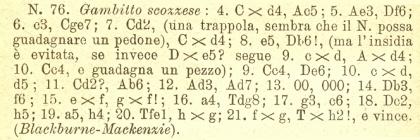
1 e4 e5 2 Nf3 Nc6 3 d4 exd4 4 Nxd4 Bc5 5 Be3 Qf6 6 c3 Nge7 7 Nd2 Nxd4 8 e5 Qb6 9 Nc4 Qe6 10 cxd4 d5 11 Nd2 Bb6 12 Bd3 Bd7 13 O-O O-O-O 14 Qb3 f6 15 exf6 gxf6 16 a4 Rdg8 17 g3 c6 18 Qc2 h5 19 a5
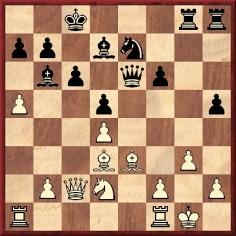
19...h4 20 Rfe1 hxg3 21 fxg3 Rxh2 and wins.
What is known about the game? It was still being given, in unchanged format, in much later editions of Salvioli’s book. See, for instance, page 546 of the eighth edition (Florence, 1961).
(5935)
Vitaliy Yurchenko (Uhta, Komi, Russian Federation) remarks that the game is on page 338 of T. Harding’s new book about Blackburne: Blackburne v Arthur John Mackenzie, simultaneous exhibition, Birmingham, 18 October 1894, as published in the Birmingham Weekly Mercury, 20 October 1894.
We note Harding’s comment that it was included in the book ‘chiefly to clear up a confusion because the win has sometimes been attributed to G.H. Mackenzie’. The corresponding endnote (page 552) provides no information as to where any such attribution has been made, but refers only to our C.N. item, posted ‘on 34 [sic] January 2009’. That material (C.N. 5935) did not mention G.H. Mackenzie.
(9525)
C.N. 5696 quoted some pen-portraits concerning New York, 1889, from page 5 of the New York Times, 26 March 1889. Below is the paragraph concerning Blackburne:
‘Most of the players have very well developed craniums, and most of them smoke, but they seem to differ in temperament and in the quality of liquids which they imbibe. Blackburne is about 50 years old, of a rather florid complexion, and deliberate in his movements. He is fond of smoking a short briarwood pipe, crossing his legs, and quietly waiting for his antagonist to rack his brains over the next move. His opponent was Mr Hanham, a nervous little gentleman of about the same age, who hardly ever takes his eyes from the chess board. As the game progresses color mounts to his face and fire in his eye.
Stephen Davies (Kallista, Australia) reports that further
pen-portraits of the participants in New York, 1889 were published
on page 8 of the New York Times, 16 June 1889, under the
heading ‘The Chessboard Kings’, with the subtitle ‘Ways and looks
of 20 great players’. The extracts transcribed below (which often
go awry with the players’ ages) focus on physical descriptions.
On Blackburne:
‘Blackburne is about 50 years of age, and rather tall, with a small, light-colored beard a little mixed with gray. Although his expression is mild and phlegmatic, it is marked with self-esteem, and in his talk he can throw in now and then bits of cutting sarcasm. He has a patient, plodding look while at play, but when he is making up some intricate combination his face becomes slightly suffused, and his eyes assume a far-away look. ... He is fond of smoking and hugely enjoys sitting back in his chair and puffing away cross-legged, but with his eyes always on the board. His pipe often goes out, and he burns up an enormous number of matches. He took a fancy to American cigars and also appreciated good old rye ...
(5710)
Some observations about Blackburne in London, 1899 Pen-portraits (our translation from an article on pages 210-213 of La Stratégie, 15 July 1899):
‘British patriotism warmly welcomed the fact that Lasker’s sole defeat was at the hands of the old English champion Blackburne, who, during the tournament, also defeated Pillsbury twice. Blackburne is the epitome of the phlegmatic old Englishman, and it is clear, when one observes him, that although chess has its charms, there is also much pleasure and, when necessary, solace to be derived from a good pipe and a glass of whisky.’
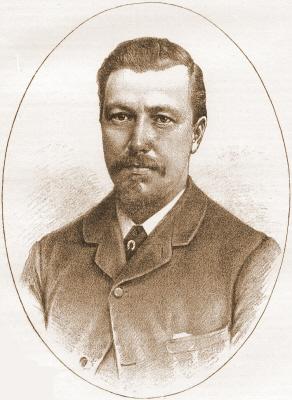
A number of webpages and other outlets specializing in (i.e. making do with) unattested ‘chess quotes’ loosely attribute to J.H. Blackburne the remark ‘chess is a kind of mental alcohol’. A contemporary source is long overdue, so we mention that the observation is to be found in an interview with Blackburne which originally appeared in the Daily Chronicle and was reproduced on pages 87-88 of the 1 May 1895 issue of the Chess Player’s Chronicle:
‘Chess is a kind of mental alcohol. It inebriates the man who plays it constantly.’
Below is the full item from the magazine:
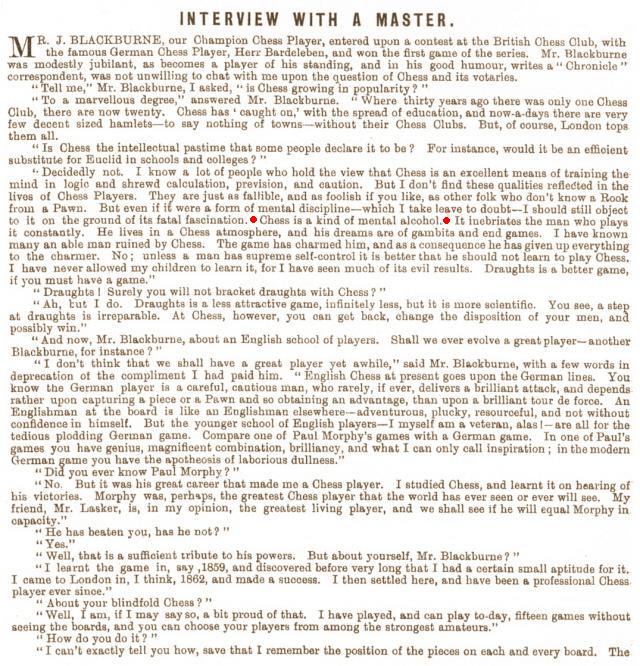

(5940)
An addition to C.N. 5940 and, in particular, to the Blackburne-related material cited on pages 238-239 of Kings, Commoners and Knaves:
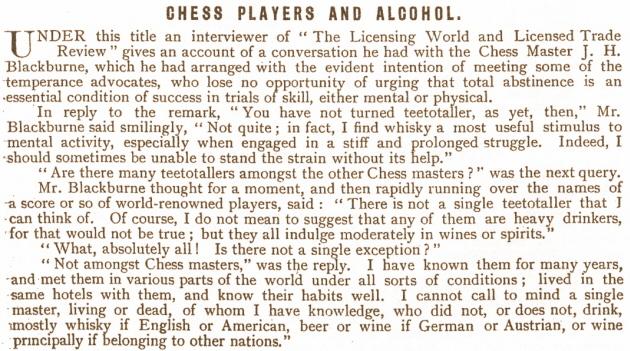
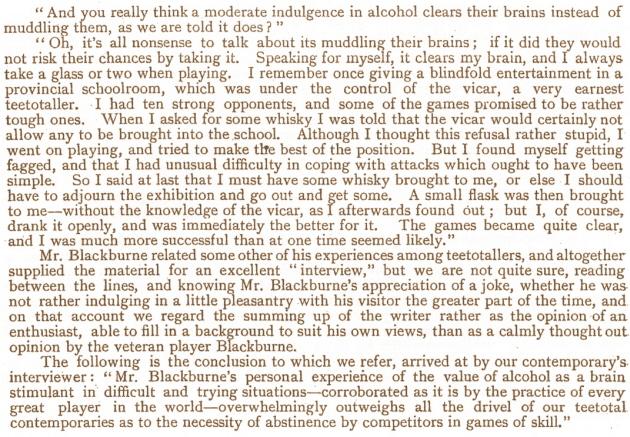
Source: pages 86-87 of the Chess Player’s Chronicle, 3 May 1899.
Kings, Commoners and Knaves quoted a slightly different version of Blackburne’s interview with Licensing World (an anti-temperance journal) and gave the score of an 1881 game he won against a player named Brewer. It is not clear whether this is the H. Brewer mentioned on page 104 of the Chess Monthly, December 1880. In this connection we also recall the game Blackburne v Lush (Melbourne, 8 January 1885) given on page 238 of the April 1885 issue of the Chess Monthly and on page 286 of P. Anderson Graham’s monograph on Blackburne.
(6043)
The conclusion of our 1997 article in Kingpin (see also pages 238-239 of Kings, Commoners and Knaves):
The following game was published by the Cincinnati Commercial in 1881 but was not included in P. Anderson Graham’s monograph on Blackburne. Black’s name is appropriate to our theme.
Joseph Henry Blackburne (simultaneous) – Brewer
London, 1881
King’s Gambit Accepted1 e4 e5 2 f4 exf4 3 Nf3 g5 4 h4 g4 5 Ne5 Bg7 6 d4 Nf6 7 Nxf7 Kxf7 8 Bxf4 d5 9 Nc3 Nxe4 10 Nxe4 10 Nxe4 Re8 11 Be5 dxe4 12 Bc4+ Be6 13 O-O+ Kg8
14 Qxg4 Qd7 15 Bxe6+ Rxe6 16 Bxg7 Rg6 17 Rf8+ Kxg7 18 Qxd7+ Nxd7 19 Rxa8 Resigns.
See also Chess and Alcohol.
Page 202 of Mr Blackburne’s Games at Chess by P. Anderson Graham (London, 1899) gave, with sketchy information, an eight-move extract from a blindfold game won by Blackburne in London against a player named Tuck. Below is the full score, from page 326 of the Chess Player’s Chronicle, 16 October 1895:
Joseph Henry Blackburne (blindfold) – F.W. Tuck
London, 5 October 1895
Vienna Gambit
1 e4 e5 2 Nc3 Nf6 3 f4 d6 4 Nf3 Nc6 5 Bb5 Be7 6 fxe5 dxe5 7 Nxe5 Bd7 8 Nxd7 Qxd7 9 d4 a6 10 Bxc6 bxc6 11 O-O O-O 12 e5 Nd5 13 Ne4 Qe6 14 Qh5 f6 15 Bd2 f5 16 Ng3 g6 17 Qh3 c5 18 c4 Nb4
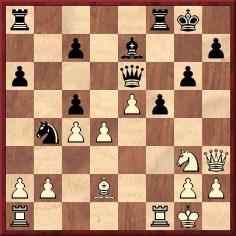
19 d5 Qxe5 20 Bc3 Qe3+ 21 Kh1 Qg5 22 Rae1 Nxa2 23 Be5 Bd6 24 Ne4 Qe7 25 Bxd6 cxd6 26 Nxc5 Qg5 27 Ne6 Qf6 28 Qa3 Rab8 29 Nxf8 Rxb2 30 Nd7 Resigns.
The game was played in an eight-game blindfold display at the City of London Chess Club. The date is gleaned from the report on page 307 of the 9 October 1895 issue of the Chronicle. Blackburne scored +4 –0 =4, ‘completing the whole of the games in very quick time’.
(6030)
First, we reproduce an item from page 342 of A Chess Omnibus:
Who originated the aphorism, ‘Never miss a check, it might be mate’? The earliest documented reference known to us is the Liverpool Weekly Mercury of 8 November 1890, quoting from the Birmingham [Daily] Gazette. The remark was attributed to Blackburne, at a simultaneous exhibition in Birmingham in 1890.
The comment ‘Never miss a check’ (without the other four words) appeared in the comments about a Blackburne position on page 25 of the Chess Monthly, September 1882:
L.-J.H. Blackburne, London, 20 October 1880
Played at Simpson’s, with Blackburne giving the odds of two knights1…Be7 2 Bxe5+ (‘Of course White cannot resist the temptation, and why should he? “Never miss a check.”’) 2…Qxe5 3 Nxe5 Rxg2+ 4 Kxg2 Rg6+ 5 Kh3 Bg2 mate.
By the time of his death, the remark ‘Never miss a check, it might be mate’ was routinely being ascribed to Blackburne (e.g. BCM, October 1924, page 401).
(6416)
See the Factfinder for further citations.
From page 936 of volume five of the Oxford Dictionary of National Biography (Oxford, 2004), in the entry on J.H. Blackburne:
‘When the great players of the world met for the London tournament of 1922 he was too ill to attend. In the autumn of that year J.R. Capablanca, the world champion, visited him at his bedside.’
Is any further information available?
(6417)
Our Chess with Violence article quotes Steinitz (addressing Hoffer) from pages 332-333 of the November 1889 International Chess Magazine:
‘... this brave Blackburne, whose blackguardly fisticuff performances you want to glorify at my expense, has never to my knowledge struck a man of his own size, unless it were in the case of an assault on board ship, during his journey to Australia, for which he was fined £10 at the police court, on his landing in Melbourne.’
Jerry Spinrad (Nashville, TN, USA) now supplies a report on Blackburne’s action, from page 2 of the Timaru Herald of 30 January 1885:
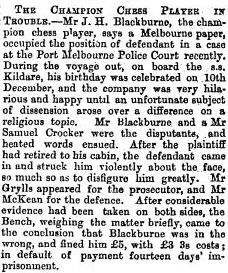
(6437)
Olimpiu G. Urcan (Singapore) points out a report on page 5 of the Melbourne newspaper The Argus of 22 January 1885 which is favourable to Blackburne’s side of the fisticuff affair:
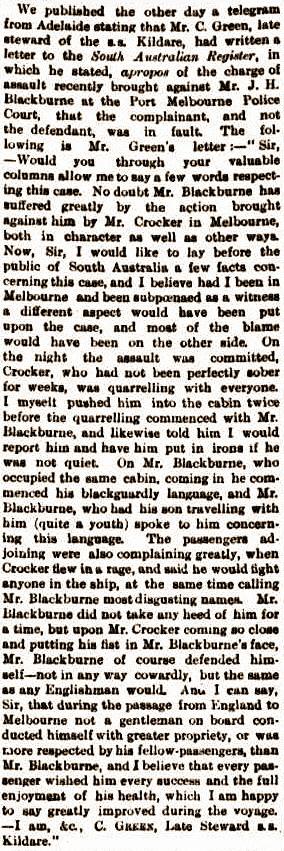
(6440)
Three years before playing Steinitz for the world championship, Gunsberg lost a match-game in 11 moves:
Joseph Henry Blackburne – Isidor Arthur Gunsberg
Eighth match-game, Bradford, 6 October 1887
Ruy López
1 e4 e5 2 Nf3 Nc6 3 Bb5 Nf6 4 Qe2 a6 5 Ba4 Bc5 6 c3 b5 7 Bc2 d5 8 exd5 Qxd5 9 d4 Bd6 10 Bb3 Qe4 11 Qxe4 Resigns.
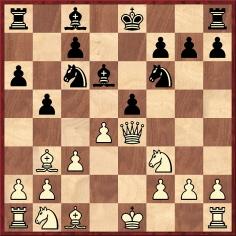
Sources: BCM, November 1887, pages 429-430 (which included the players’ brief notes) and Chess Monthly, December 1887, pages 112-113.
There are databases which have the move order as 3...a6 4 Ba4 Nf6 5 Qe2 Bc5 and, even, are wrong about the occasion of the game (e.g. giving the date as 1890).
(6508)
Further to C.N. 6509 (Blackburne v Lipschütz, New York, 1889), Stephen Davies notes a passage on page 56 of Grandmasters of Chess by Harold C. Schonberg, (Glasgow, 1975):
‘It was during the above New York 1899 [sic] tournament that Blackburne demolished S. Lipschütz. The Jewish player remarked to the spectators, “Der alte Goniff hat mir geschwindeit [sic]!” – “The old crook has swindled me”. Blackburne, who knew German but not Yiddish, went around asking if “Goniff” meant “gentleman”.’
Our correspondent also notes the following on pages 186-187 of The Delights of Chess by Assiac (London, 1960):
‘One of Mieses’ favourite stories was concerned with old Blackburne, who, at some Continental tournament, had asked him the meaning of the word ganef.
“Why do you want to know?”, asked Mieses.
“Well”, said the Englishman, “after I had trounced Gunsberg this morning I heard him say to someone: ‘Der alte Ganef hat mich mattgesetzt.’ I know, of course, that der alte means old and mattgesetzt means mated. But what the dickens is a ganef?”
Mieses was loath to tell him that, strictly speaking, it was Yiddish for “crook”. So he told him not to worry. The word didn’t really mean much, and the way Gunsberg had used it, he certainly had meant no offence.
But the stubborn old Englishman wasn’t satisfied with so vague an explanation, and when Mieses kept on giving evasive answers, Blackburne asked him point-blank: “Tell me one thing. Can one be a ganef and a gentleman at the same time?’
After some consideration, Mieses reassured him on this point.’
Mr Davies asks whether a contemporary source is available for this anecdote.
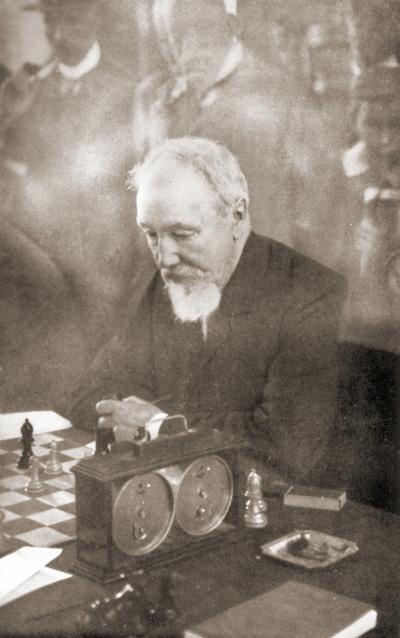
We note, firstly, that the Schonberg passage was not in the original (1973) publication of Grandmasters of Chess but appeared (with the amendments 1889 and geschwindelt) on page 70 of the revised and updated 1981 edition.
M.V. Anderson of Melbourne asked about the origins of the story (the alleged exclamation being ‘The Gonim has swindled me again’) on page 11 of the January 1958 BCM, in D.J. Morgan’s Quotes and Queries column. It was noted that a version (concerning Blackburne and Nimzowitsch at St Petersburg, 1914) had appeared on page 98 of Caïssas Weltreich by M. Euwe and B. Spaak (Berlin-Frohnau, 1956):
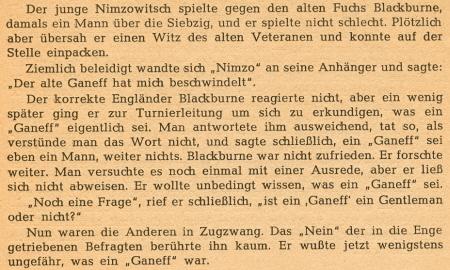
Nimzowitsch made no mention of such an incident when annotating his loss to Blackburne in the Rigasche Rundschau (see pages 133-134 of the June 1918 Deutsche Schachzeitung).
On pages 100-101 of the April 1958 BCM D.J. Morgan reverted to the subject, having been informed by Fred Reinfeld of a passage on pages 344-345 of the Vienna, 1898 tournament book (in the article in Pester Lloyd by Armin Friedmann which was referred to in C.N. 5121). Below is the English translation published on page 62 of the August 1898 American Chess Magazine:
‘Old Mr Blackburne, of London, is also present – a chieftain with the most immovable quietude of soul, whom nothing on earth could throw out of his equanimity. He, too, was at one time a mighty victor, and in many an important contest did he carry off first honors. He bears his misfortunes less tragically; he smokes his short-stemmed pipe, and quietly addresses his victorious antagonist in German, using the only two German words he has learned here – one of which is not German at that – “Grosser Ganef”. The hoary fellow, with his healthy, rosy cheek, and brightly twinkling eyes, has a splendid dry humor ...’
After quoting Reinfeld, D.J. Morgan’s column gave the following:
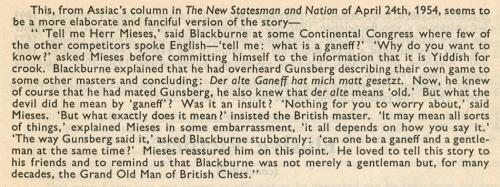
On pages 162-163 of the June 1958 BCM Morgan quoted a contribution to his column from Assiac:
‘As for your Melbourne reader’s query: first, there’s no such word (yiddish or otherwise) as “gonim”, there’s only a ganeff. (In fact, there should be quite a few of them.) Reinfeld’s reference to Vienna, 1898 is very interesting, and the fact that Blackburne had come to like terms such as “Grosser Ganeff” seems to fit in neatly with what Mieses told me about his (prior) experience of reassuring Blackburne that one can be a gentleman and a ganeff at the same time (this sort of ganeff at any rate). Hence, we haven’t two different versions of the same story; we have two different stories, related as cause and effect.’
(6513)
Avital Pilpel (Haifa, Israel) refers to two articles on his Jewish Chess History website, A Porat Interview, a Najdorf Quip, and a Nimzowitsch Story and ‘Ganef:’ The other Side of the Story. He also comments to us:
‘“Ganef” is customarily used as a mild expression of annoyance or disapproval, often humorously, and not as a literal claim that someone is a thief or scoundrel.’
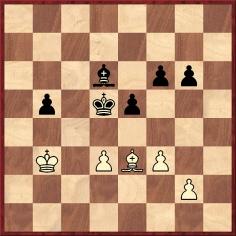
This position occurred after 41...Kd5 in Weiss v Blackburne, New York, 1889. Paul Gottlieb (East Brunswick, NJ, USA) notes that whereas databases state that the game continued 42 Bf2 f5 43 Kc3 g5, a sequence leading to a different position was given by Irving Chernev on page 144 of The Most Instructive Games of Chess Ever Played (New York, 1965):
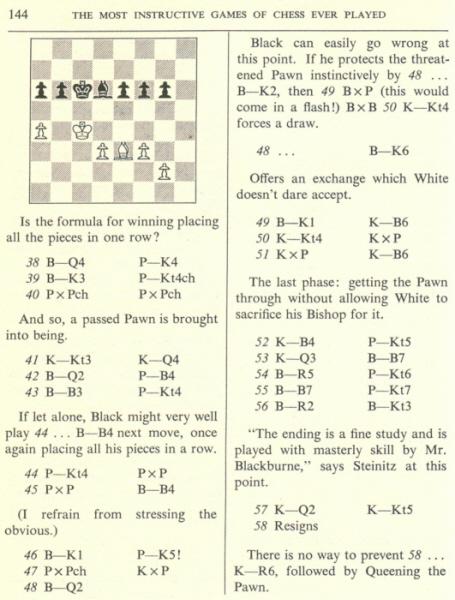
We have found no corroboration of the Chernev version, whereas 42 Bf2 f5 43 Kc3 g5 was the continuation given on page 5 of the New York Times of 27 April 1889 (the day after the game was played), page 145 of the May 1889 International Chess Magazine, page 75 of the tournament book by Steinitz, and page 127 of P. Anderson Graham’s book on Blackburne.
Chernev was, of course, aware of Steinitz’s annotations (at move 56 he quoted one of the world champion’s comments), so why did he give different play at moves 42 and 43?
(6644)
Marc Hébert (Charny, Canada) asks for information about the famous blindfold game in which J.H. Blackburne announced mate in 16 moves.
The conclusion was published on page 211 of Mr Blackburne’s Games at Chess by P. Anderson Graham (London, 1899), with the solution on page 326:
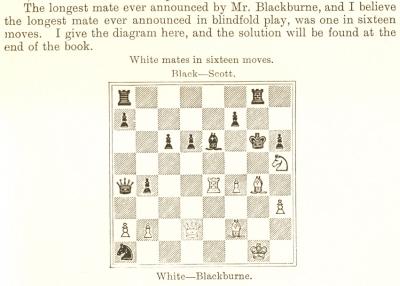
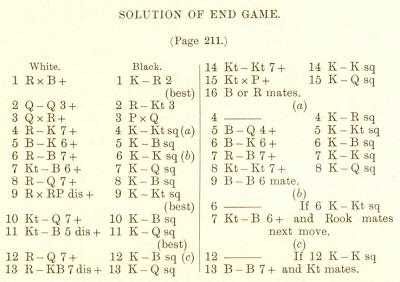
Thus the only information supplied was Black’s name: Scott. It was not stated that the game had occurred in a simultaneous display, although that assumption is commonly made.
The position was given on page 41 of Blindfold Chess by E. Hearst and J. Knott (Jefferson, 2009), the co-authors stating that they had been unable to find any further particulars. Where, if anywhere, was the position published before the appearance of P. Anderson’s Graham book? We also seek bare references in nineteenth-century sources to such a game, or to an opponent of Blackburne’s named Scott.
(6691)
Jerry Spinrad draws attention to the Sydney Mail of 19 February 1887 (page 411), which reproduced from the Fortnightly Review an article The Chess Masters of To-day by Leopold Hoffer:
‘There are masterpieces of Blackburne’s blindfold games published in which he has announced checkmate in 17 moves.’
We note that the same remark appeared on page 162 of the Chess Monthly, February 1889.
Which games published before 1887 could Hoffer have had in mind?
Taylor Kingston (Shelburne, VT, USA) comments regarding the position in C.N. 6691, where Blackburne is said to have announced mate in 16 moves, that White can give mate in eight. After 1 Rxe6+ Kh7 2 Qd3+ Rg6 the announced mate was 3 Qxg6+ fxg6 4 Re7+ Kg8 5 Be6+ Kf8 6 Rf7+ Ke8 7 Nf6+ Kd8 8 Rd7+ Kc8 9 Rxa7+ Kb8 10 Nd7+ Kc8 11 Nc5+ Kd8 12 Rd7+ Kc8 13 Rf7+ Kd8 14 Nb7+ Ke8 15 Nxd6+ Kd8 16 Rd7. The analysis engine Rybka agrees that this is the best play for both sides if White chooses 3 Qxg6+, but it gives the line 3 Rxg6 fxg6 4 Qxd6 Qd1+ 5 Bxd1 gxh5 6 Qe7+ Kh8 7 Bd4+ Kg8 8 Qg7 mate.
(6698)
On pages 366-367 of the December 1886 International Chess Magazine Steinitz wrote about a question which he had been asked ...
‘... many years ago in London by an habitué of a public chess resort, who in polite terms requested me to show him the best moves of the Two Knights Defense. “There has been”, I answered, “a whole book written by Bilguer on that opening in German. Which particular variation do you refer to?” He did not know how to describe it. “Well”, I said, “perhaps you will recognize it if I show you one or two of the main lines of play.” “Thank you very much.” Whereupon I rattled off the well-known variation in which the knight is sacrificed for the KBP, on the sixth move. My interlocutor looked on attentively for some time, but at last he said: “That is not the Two Knights Defense I meant. What I want to know is this: Mr Blackburne always gives me the odds of two knights, and I never know how to defend myself.”’
The story was also related on pages 8-9 of The Bright Side of Chess by Irving Chernev (Philadelphia, 1948).
(6779)
On page 13 of The Wisest Things Ever Said About Chess (London, 2008) Andrew Soltis gave a source:
‘“Never commence your final attack until the queen’s rook is in play”, Joseph Blackburne wrote in his game collection.’
We have not found those words in Mr Blackburne’s Games at Chess (London, 1899), but sentiments along the same lines are regularly ascribed to the English master. See, for instance, the quotations offered by Irving Chernev on page 14 of CHESS, October 1974 and on page 22 of The Golden Dozen (Oxford, 1976). In his notes to Game 7 in Logical Chess Move by Move (various editions) Chernev gave a rather different wording:
‘Blackburne used to say, “Never start an attack until your queen’s rook is developed”.’
A second-hand version appeared on page 489 of the November 1933 BCM (in the Game Department, conducted by J.H. Blake):
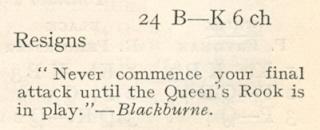
There was a more general remark on pages 19-20 of Chess Openings by F.J. Marshall (Leeds, 1904):
‘Never start an attack until the development of the fighting force is complete or well advanced.’
(6824)
Moshe Rubin (Jerusalem) is researching John Francis Byrne (1880-1960), who lived in Dublin until 1910 and thereafter in New York City. In 1953 Byrne, a close friend and colleague of James Joyce, published Silent Years: An autobiography with memoirs of James Joyce and our Ireland, and we are grateful to Mr Rubin for sending us two chapters with much chess content.
Chapter Five (pages 48-57) is entitled ‘Congress v House of Commons at Chess’ and describes, in particular, Byrne’s games with John Howard Parnell. His encounters with some masters are related in Chapter Sixteen (‘I Lecture on Spinoza’) on pages 178-187. In the early part of the twentieth century ‘in this new Sackville Chess Club I quickly became a top chessplayer; and during several years won as many first-prize gold medals’. From pages 179-180:
‘As an indication of the standard of chess played in Dublin, I can relate a couple of facts. One afternoon in the Sackville Chess Club, I was sitting alone and unoccupied, when a middle-aged, stout and florid gentleman with a large blue patch over one eye approached me and asked me in Teutonic accent whether I would care to play a game of chess with him. I said I would and we did. And as the game progressed, I noticed to my astonishment that a big crowd of kibitzers gathered around our table. After we had played a while the game developed into what was, I knew, a winning position for me; and at this point I was amazed when my opponent suddenly stretched out his arm, swept all the pieces off the chessboard, and said, “It’s yours – will you play another?” We played again; and this time, before the game was finished he said, “It’s a draw – have another?” I refused to play a third, because I had to go away; and when I got up to leave, several members of the club clustered round me clapping me on the back, saying, “Well done, Byrne, you gave him quite a shock.” “But who is he, I never saw him before?”, I asked. “Didn’t you know? He’s Teichmann.”
Teichmann was at that time a prominent international chess master, who usually came out somewhere about fourth in the international tournaments. The Sackville Club had been in correspondence with him about giving some exhibitions in Dublin, and when he arrived he was met by Porterfield Rynd, who escorted him to the club where, without my being aware of what was afoot, he sicked him on to me. Rynd was very fond of a little practical joke. He himself was a really good player; and he knew, though I was not a student of chess, that I was a player who had a winning chance against anyone. Another chess master who came to Dublin for exhibition purposes was an Englishman named Lee. He also played in international tournaments, but usually did not do so well as Teichmann. With Lee I played a few solo games; and I felt quite sure that if I were to play a match with him I could beat him, but I also felt doubly sure that I never would play a serious match with him – or anyone else. The strange thing about Lee is that I remember him so vividly. If I were an artist, I could sketch him exactly as he appeared to me then. He looked to be in his middle fifties, about my own size, with long pasty face, grey eyes, sparse and thin greying hair brushed back from his forehead, large, but not protruding ears, thin grey moustache, a quiet manner, and soft, but slightly raucous voice, this quality in it being probably due to his continuous pipe smoking combined with his love for snuff. He wore a high collar, large cravat, frock coat, striped trousers and spats. And as I played with him and thought about him I marveled how in the name of heaven he was able to make both ends meet as an itinerant professional chessplayer. And the more I thought about Lee, or Teichmann for that matter, the less I wanted to play any professional chessplayer in those simultaneous exhibitions. In play either against Teichmann or Lee, I won a brilliancy prize; but instead of feeling elated over this, I felt sad. These fellows, I realized, were eking out a precarious existence dragging the devil by the tail, and I felt no glory in adding my poundage to his satanic majesty.
A third professional who visited Dublin in my time for exhibition purposes was the famous Blackburne. His exhibition in the Sackville Chess Club consisted of playing blindfolded against about eight players simultaneously. I was an emcee that night – relaying moves, and helping Rynd, who was a long-time personal friend of Blackburne’s, to prepare vast quantities of whiskey punch to slake the eager thirst of the aged, daddy-Christmas-looking chess master. And, inspired no doubt by his spirituous quaffing, Blackburne won a smashing victory.’
Our correspondent asks whether it is possible to find other writings on chess by Byrne, or any of his game-scores.
(6833)
John Blackstone (Las Vegas, NV, USA) points out this letter on page 11 of the New York Evening Post, 5 October 1910:
‘My dear Blackburne,
I notice with a great deal of pleasure the movement which has been set on foot to commemorate the completion of 50 years of chess life in your career, and I want to add my personal good wishes to the many that will pour in upon you as the brilliant and much-loved representative of British chess. Your style of play, which to my mind should be cultivated much more than it is, has always appealed to me, and I believe I have profited much by a study of your famous games. Whether I have lost or won I have thoroughly enjoyed the games we have had together and both because of your standing in the chess world and my own regard for you I value as such the privilege of having met you so often face to face across the chequered board.
Regretting my inability to greet you personally on this auspicious occasion and hoping you may long survive in the interest of the cause you espoused and for the gratification of your man [sic], friends and admirers I remain yours very sincerely
(Signed) Frank J. Marshall
New York, 29 September.’
The result of the jubilee testimonial for Blackburne was announced on page 322 of the August 1912 BCM:
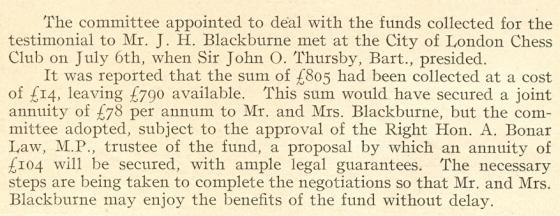
(7114)
Another version of an old tale, this time with Blackburne supposedly claiming that he was the player in question:
‘A good story is told by J.H. Blackburne, which runs as follows:
“When playing a game once at a London Chess Club I saw that by moving my king and allowing my opponent to capture my knight I could announce mate. Fearful that my opponent would notice this, I deliberately made a false move with the knight, and my opponent pounced upon this and made me move my king. Needless to say, my man took the knight, and I blandly announced mate in four.”’
Source: Chess Amateur, November 1921, page 36.
(7206)
An odds game played at the City of London Chess Club:
Joseph Henry Blackburne – Younger
London, 1871 (?)
(Remove White’s king’s knight.)
1 e4 e6 2 d4 d5 3 Nc3 c5 4 exd5 exd5 5 dxc5 d4 6 Ne4 Qe7 7 Bb5+ Bd7
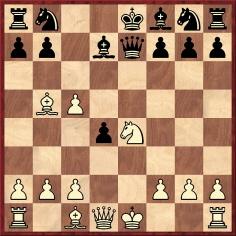
8 O-O Bxb5 9 Re1 Kd8 10 Bg5 f6 11 Nxf6 gxf6 12 Rxe7 Bxe7 13 Qxd4+ Nd7 14 b4 h6 15 Bf4 Bc6 16 Rd1 Kc8 17 c4 b6 18 cxb6 Bxb4 19 Qb2 Bc5 20 b7+ Bxb7 21 Rxd7 Bb6 22 Qb5 f5
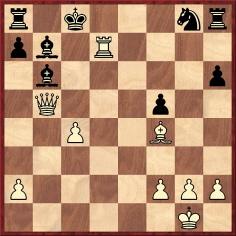
23 Rc7+ Bxc7 24 Qe8+ Bd8 25 Qe6 mate.
Source: page 83 of the Westminster Papers, 1 September 1871.
(7238)
Dominique Thimognier (Fondettes, France) mentions that his website includes a page on Maurice Billecard. Our correspondent notes, in particular, that at the time of the Ostend, 1907 tournament Billecard was working as a judge in Cherchell, a town 90 kilometres from Algiers.
In the Ostend tournament Billecard defeated, among others, Blackburne, Mieses, Swiderski and Teichmann, and he annotated a number of his wins in Illustration Algérienne, Tunisienne et Marocaine. We are grateful to Mr Thimognier for the pages (27 July 1907, page viii, and 3 August 1907, page 4) which had Blackburne v Billecard, given that only the first 28 moves were in the tournament book (pages 260-261).
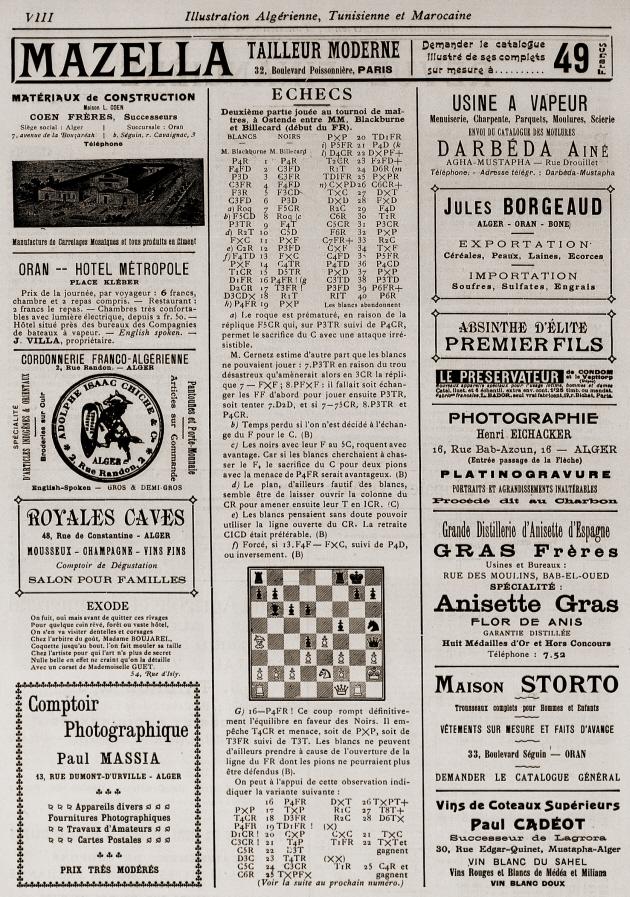
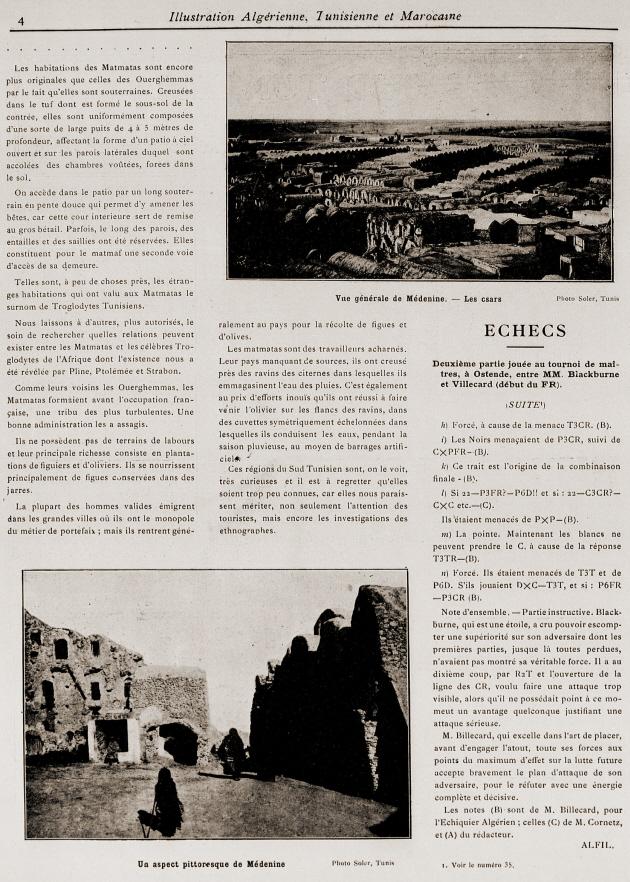
Joseph Henry Blackburne – Maurice Billecard
Ostend, 1907
Bishop’s Opening
1 e4 e5 2 Bc4 Nc6 3 d3 Nf6 4 Nf3 Bc5 5 Be3 Bb6 6 Nc3 d6 7 O-O Bg4 8 Bb5 O-O 9 h3 Bh5 10 Kh2 Nd4 11 Bxd4 exd4 12 Ne2 c6 13 Ba4 Bxf3 14 gxf3 Nh5 15 Rg1 Qh4 16 Qf1 f5 17 Bb3+ Kh8 18 Qg2 Rf6 19 f4 fxe4 20 dxe4 Raf8 21 f5
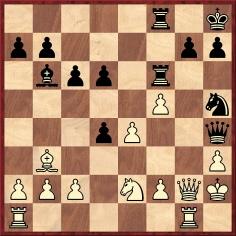
21...d5 22 Qg4 Qxf2+ 23 Rg2 Bc7+ 24 Kh1 Qe3 25 Rf1 dxe4 26 Nxd4 Ng3+ 27 Rxg3 Qxg3 28 Qxg3 Bxg3 29 Kg2 Be5 30 Ne6 Re8 31 Ng5 g6 32 Be6 gxf5 33 Nf7+ Kg7 34 Nxe5 Rexe6 35 Nc4 f4 36 a4 b5 37 axb5 cxb5 38 Na3 a6 39 c3 f3+ 40 Kh1 e3 41 White resigns.
(7324)
A famous brilliancy won by Blackburne:
1 e4 e5 2 d4 exd4 3 Qxd4 Nc6 4 Qe3 g6 5 Bd2 Bg7 6 Nc3 Nge7 7 O-O-O O-O 8 f4 d5 9 exd5 Nb4 10 Bc4 Bf5 11 Bb3 Nexd5 12 Nxd5 Nxd5 13 Qf3 Qf6 14 c3 Nb4 15 Bc4
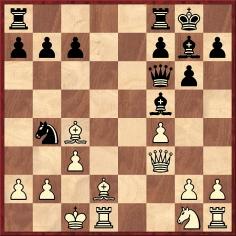
15...Qa6 16 g4 Qxa2 17 Be3 Bxc3 18 White resigns.
The game (‘played at Hastings in 1892’) is on page 176 of the P. Anderson Graham book Mr Blackburne’s Games at Chess (London, 1899), which identifies White as ‘Dr Colbourne’. The same appears in such popular books as Chernev’s 1000 Best Short Games of Chess (page 228). As so often, databases propose other spellings, such as Colburn and Kolborn.
Hastings had two chess figures, H. Colborne and J. Colborne, who were mentioned, for instance, as members of the Hastings, 1895 Committee on page xii of the tournament book. Nineteenth-century chess magazines include a number of references to a ‘Dr Colborne’ active in the Hastings area. He partnered Blackburne in a game against Gunsberg and Womersley, played in Hastings, which was published on pages 74-75 of the February 1894 BCM. Hastings was also the venue of a Vienna Gambit game which, partnered by Chapman, Dr Colborne lost to Blackburne (BCM, April 1895, pages 192-193). ‘Dr J.G. Colborne’ was mentioned on page 110 of the March 1898 BCM.
The Blackburne miniature is on pages 54-55 of Winning Quickly with Black by I. Neishtadt (London, 1996) as Allies v Blackburne, Hastings, 1894, with this footnote: ‘In some publications the game is given as being played in Bradford in 1901.’
However, the game is on page 142 of Chess Sparks by J.H. Ellis, a book published in 1895:
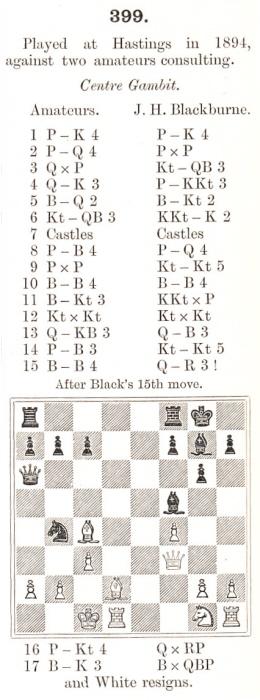
Tracing the game’s details and initial publication is more difficult than might be expected, although it was presented as a recent victory by Blackburne in Hastings against N.N. on page 50 of the February 1895 Deutsche Schachzeitung. Blackburne won the game against two amateurs according to pages 207-208 of the 15 July 1895 issue of La Stratégie (‘brillante partie jouée l’hiver dernier à Hastings’), its source being the Baltimore News. Readers’ assistance in finding other appearances of the game in nineteenth-century publications will be welcomed.
(7577)
Jerry Spinrad mentions a further complication: when the Blackburne game was published in the New York Evening Post of 19 March 1895 (page 5) White was identified as ‘N.C.’.
(7593)
An observation about J.H. Blackburne on page 54 of The “British Chess Magazine” Chess Annual 1915 by I.M. Brown (Leeds, 1916):
‘Has probably brought off more brilliant terminations than any player who ever lived.’
(7966)
An enquiry from Rick Kennedy concerning J.H. Blackburne’s nickname ‘The Black Death’ is prompted by the suggestion in a recent ChessBase article that the term relates to the master’s skill as Black.
‘Do you know the origin of the nickname, and whether it had anything to do with Blackburne’s prowess with the black pieces?’
To begin with the second part of Mr Kennedy’s question, we note that such a claim is occasionally seen in chess literature, an example being the entry on Blackburne on page 41 of Lexikon für Schachfreunde by Manfred van Fondern (Lucerne and Frankfurt am Main, 1980):
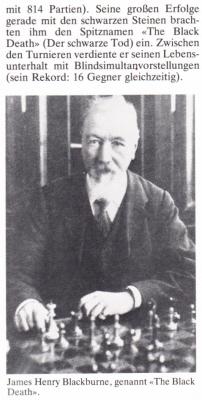
In that entry Blackburne’s first name was twice given as James, instead of Joseph. We are aware of no primary sources making a connection between ‘The Black Death’ and Blackburne’s handling of the black pieces.
As regards the origin of the sobriquet, below is a passage from pages 8-9 of Mr Blackburne’s Games at Chess by P. Anderson Graham (London, 1899):
‘There was a description published of him in the book of the Vienna tournament of 1873, which, allowing for the changes made by the years, might stand for today. Says the writer: “The pale, lean, muscular young man opposite [i.e. playing against Steinitz] is the iron Blackburne, the Black Death of chessplayers. But very seldom there falls from his moustache-covered lips a laconic English word. He surveys the game with the eye of a hawk; even now he is tearing to bits a snare laid for him by his unsuccessful opponent, and a demure smile steals over his face.”’
The Blackburne entry in the Oxford Companion to Chess affirmed, ‘The tournament book of Vienna 1873 called him “der schwarze Tod” (Black Death), a nickname that became popular’, but it would be more precise to say that Der erste Wiener internationale Schachcongress im Jahre 1873 edited by H. Lehner and C. Schwede (Leipzig, 1874) merely quoted, on page 50, from an external source:
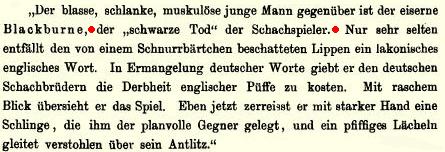
Page 48 stated that the writer of the material cited was Dr J. Pollach, in an account first published in a shorter form in the Deutsche Zeitung and later reprinted in full in chess publications.
Peter Anderberg (Harmstorf, Germany) informs us that the abridged text appeared in the Viennese daily Deutsche Zeitung on 2 August 1873, morning edition, page 4. It included the ‘Black Death’ reference:
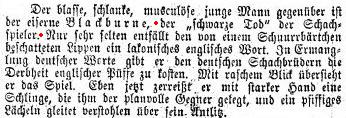
Mr Anderberg notes furthermore that although the Deutsche Zeitung named the writer only as ‘-ch’, later sources specified ‘Dr J. Pollach’, and that the text in the tournament book was reproduced from the Oesterreichische Schachzeitung, October 1873, pages 293-295.
(8014)
From our feature article Chess Photographs in the Daily Mirror:
A selection of chess-related photographs found in the Daily Mirror by Olimpiu G. Urcan is presented below. As usual in such cases, not all the information in the captions is reliable.
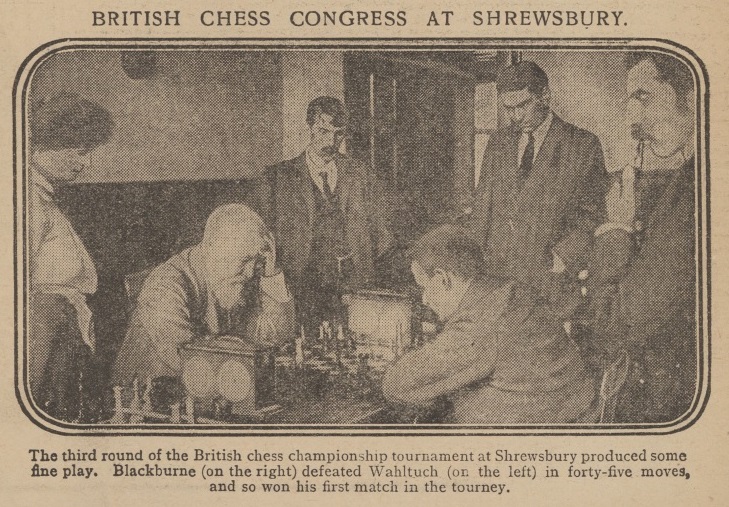
10 August 1906, page 9
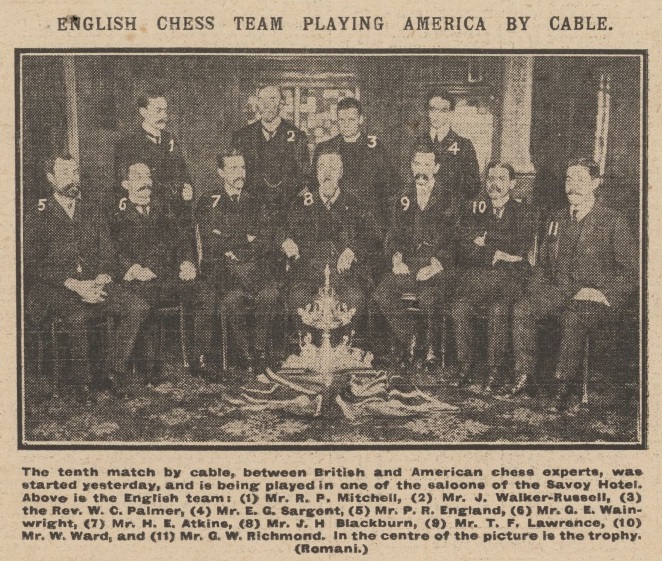
14 March 1908, page 13
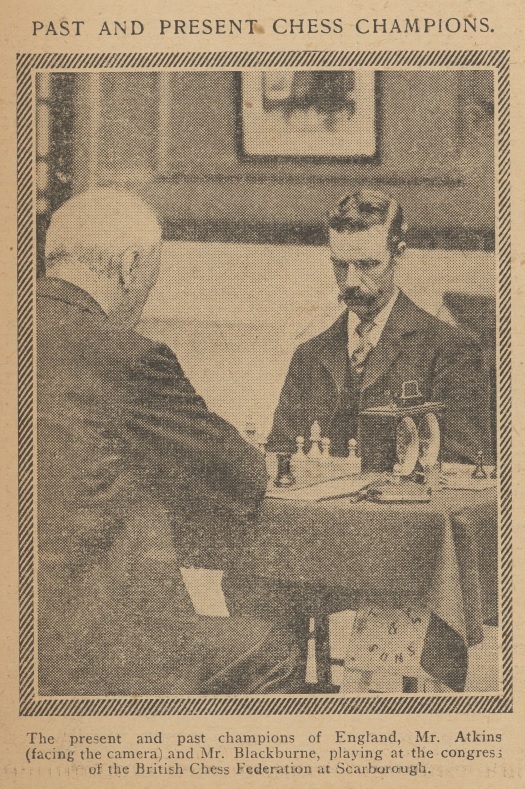
12 August 1909, page 8 (See too C.N. 9236.)
Further to C.N. 3038 (see page 325 of Chess Facts and Fables), we still hope to find corroboration of a quote included by Vera Menchik at the start of an article, ‘How to Meet an Attack’, on pages 479-482 of the Social Chess Quarterly, January 1935:
‘“Counter-attack is the soul of the game”, said Blackburne, and all the authorities agree that counter-attack is the best possible defence.’
Vera Menchik further endorsed the sentiments in the final paragraph of her article:
‘And so once more we repeat: counter-attack is the soul of the game, and it is the best possible defence ...’
(8218)
From page 102 of CHESS, April 1941:
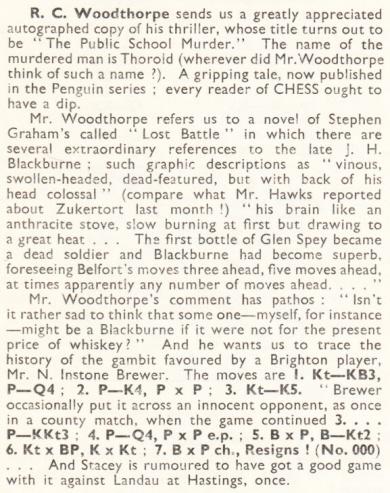
The game given (1 Nf3 d5 2 e4 dxe4 3 Ne5 g6 4 d4 exd3 5 Bxd3 Bg7 6 Nxf7 Kxf7 7 Bxg6+ Resigns) recalls the miniature (1 d4 Nf6 2 c4 e5 3 dxe5 Ng4 4 a3 d6 5 exd6 Bxd6 6 g3 Nxf2 7 White resigns) discussed in a number of items, including C.N. 7771.
We seek information about N. Instone Brewer and any game-scores involving Stacey and Landau. They met in the Premier Reserves (Section I) at Hastings, 1935-36 (BCM, February 1936, page 52), but the moves have not been found.
As regards the novel Lost Battle by Stephen Graham (London, 1934), we have an inscribed copy:
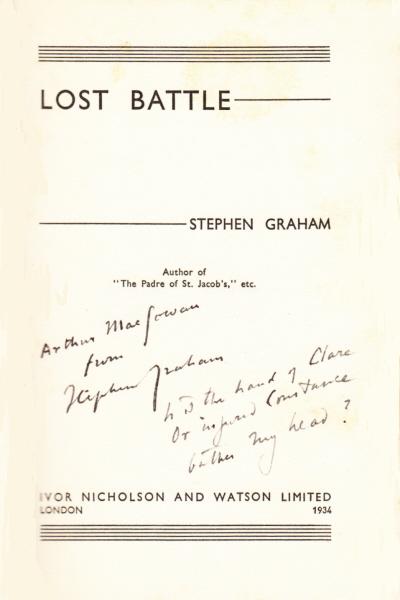
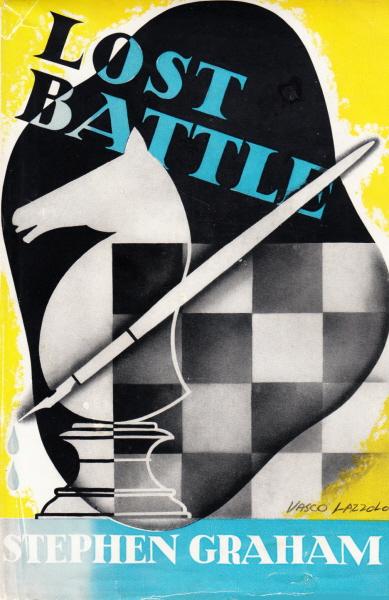
Chess is mentioned in the first paragraph and regularly throughout the book. There are many references to old players, and Blackburne in particular. Two sample pages:
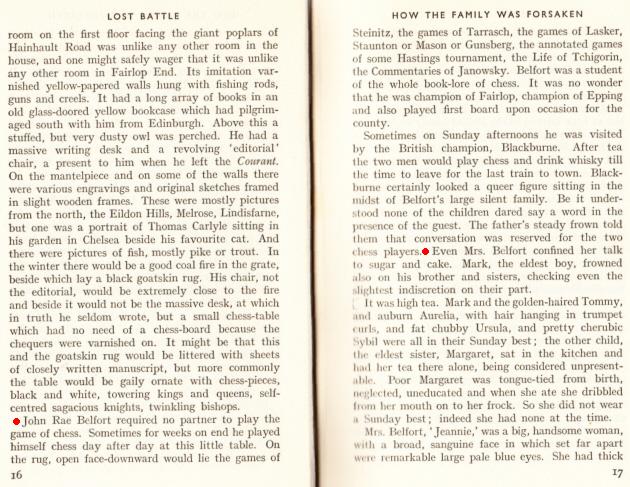
(8380)
From page 3 of the Dundee Evening Post, 16 November 1900:

A specimen of Blackburne’s play in Scotland (a victory in Glasgow against J.R. Longwill, J. Russell and A.J. Neilson) was published on page 8 of the Falkirk Herald and Midland Counties Journal, 14 November 1900:
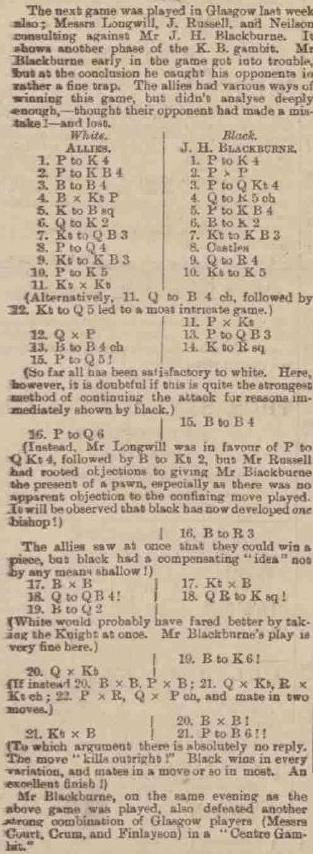
1 e4 e5 2 f4 exf4 3 Bc4 b5 4 Bxb5 Qh4+ 5 Kf1 f5 6 Qe2 Be7 7 Nc3 Nf6 8 d4 O-O 9 Nf3 Qh5 10 e5 Ne4 11 Nxe4 fxe4 12 Qxe4 c6 13 Bc4+ Kh8 14 d5 Bc5 15 d6 Ba6 16 Bxa6 Nxa6 17 Qc4
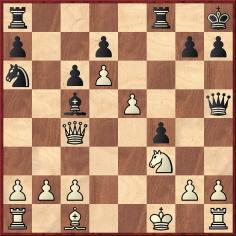
17...Rae8 18 Bd2 Be3 19 Qxa6 Bxd2 20 Nxd2
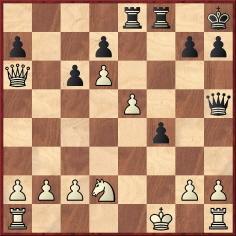
20...f3 and wins.
(8835)
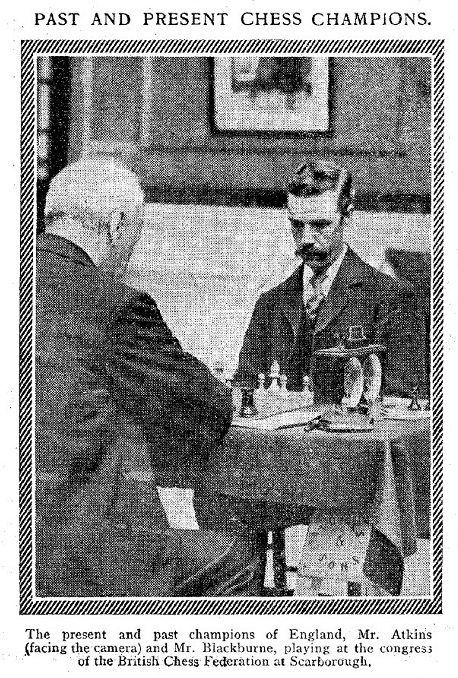
Source: Daily Mirror, 12 August 1909, page 8.
The game, a win for Atkins in 23 moves, was played on 10 August 1909 and published on page 385 of the September 1909 BCM. The photographs on page 371 of the same issue included another shot of the game:
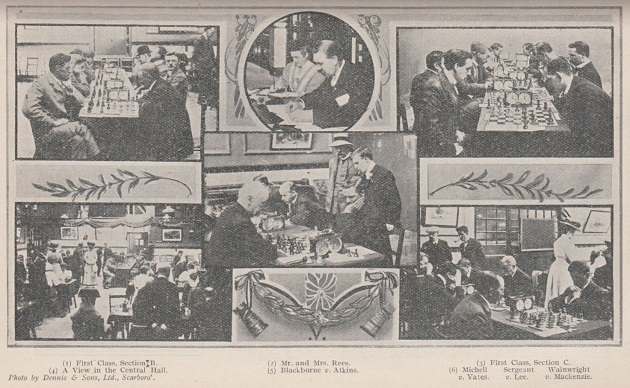
(9236)
From Olimpiu G. Urcan:
‘I have found photographs of Lasker and Blackburne in several large scrapbooks containing application forms for copyright registration filed with the Copyright Office of the Stationers’ Company (digitized via the Nineteenth Century Collections Online Database). The application forms reveal further information about the photographers, as well as the approximate date when each picture was taken.’
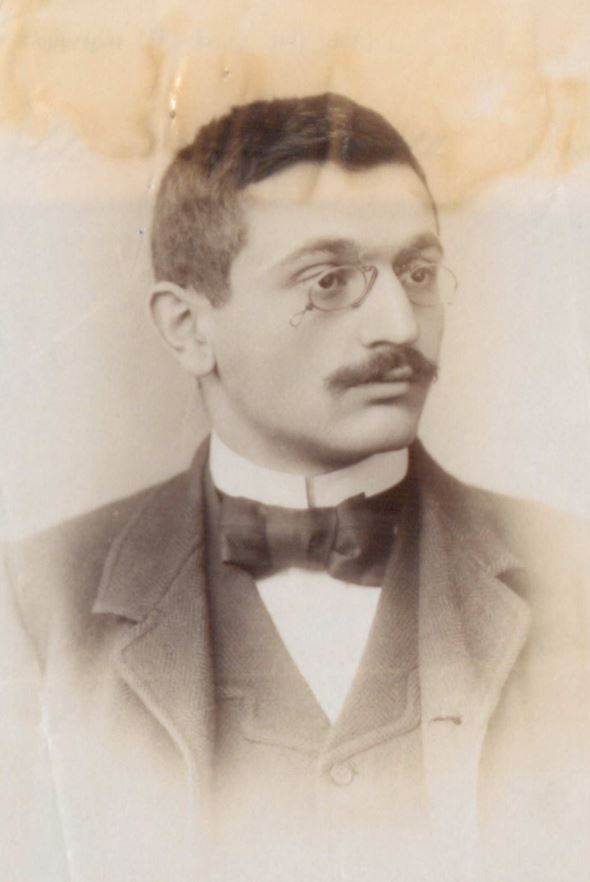
Emanuel Lasker. Photograph taken by Frederick Thomas Downey (July-September 1892)
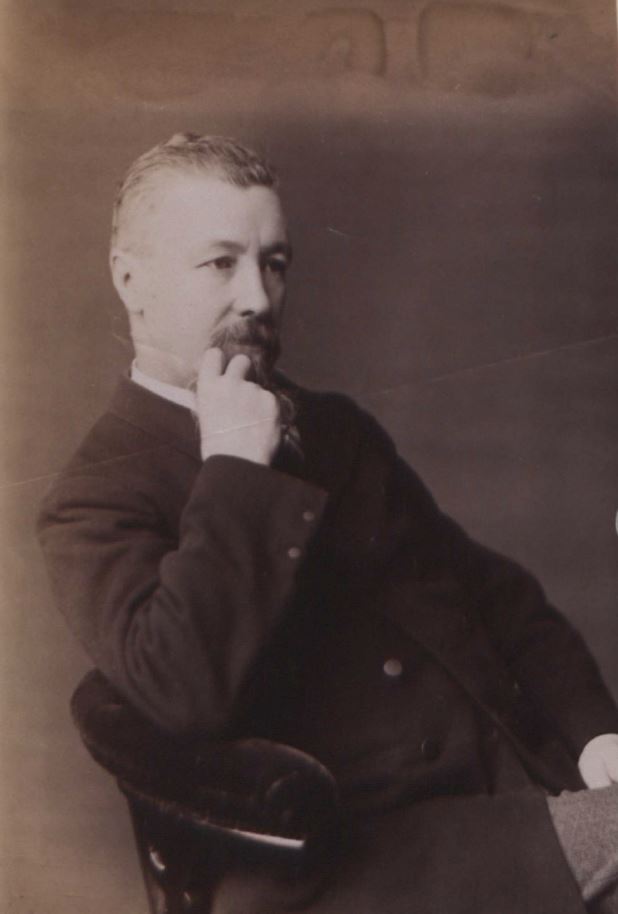

Joseph Henry Blackburne. Photographs taken by David James Scott (January 1892).
(9296)
From the chess column of A.B. Skipworth on page 6 of the Lincoln, Rutland, and Stamford Mercury, 2 November 1888:
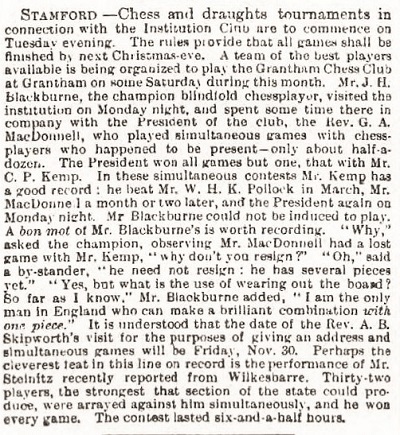
(9414)
Steinitz gave high praise to the conclusion of this game (‘played some time back at the Divan’) in his deep annotations in The Field, 6 December 1879, page 781:
Joseph Henry Blackburne – Samuel Walter Earnshaw
London (date?)
Vienna Gambit
1 e4 e5 2 Nc3 Nc6 3 f4 Bc5 4 Nf3 d6 5 Bb5 a6 6 Bxc6+ bxc6 7 fxe5 dxe5 8 Nxe5 Qd4 9 Nd3 Bb6 10 Qf3 Nf6 11 Nf2 Be6 12 d3 O-O 13 Ncd1 Rad8 14 Bg5 Qc5 15 Bxf6 gxf6 16 c3 Qg5 17 O-O Bg4 18 Qg3 Be2 19 Qxg5+ fxg5 20 Re1 Bxd3 21 Kh1 Bc4 22 b3 Be6 23 Re2 Rd7 24 Ne3 Bxe3 25 Rxe3 Rd2 26 Kg1 f5 27 Kf1 f4 28 Rd3 Rd8 29 Rxd8+ Rxd8 30 Rd1 Rxd1+ 31 Nxd1
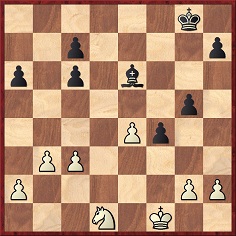
31...Bf7 32 c4 Bg6 33 Nc3 Kf7 34 Kf2 Ke6 35 b4 Ke5 36 b5 axb5 37 cxb5 Be8 38 a4 h5 39 bxc6 Bxc6 40 a5 Bd7 41 h3 g4 42 hxg4 hxg4 43 g3 f3 44 Ke3 Bc8 45 Nd1 Kd6 46 Kf4 c5 47 Nf2 Ba6 48 Nxg4 Be2 49 Kg5 c4 50 a6
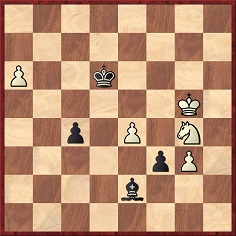
50...c3 (‘Falling into the skilfully laid trap. He relies too much on being able to queen with a ch, and no doubt he overlooked that he had no attack to follow, but actually remained with the inferior game. He should have stopped the P by K to B3; and though his opponent would then also intercede against the advance of the QBP by K to B4, Black had a good chance of drawing subsequently.’) 51 a7 c2 52 a8(Q) c1(Q)+ 53 Kf5 Kc7 54 Qa7+ Kc8 55 Ne5 Qc7 (‘Mr Blackburne’s conduct of the ending is beyond all praise.’)
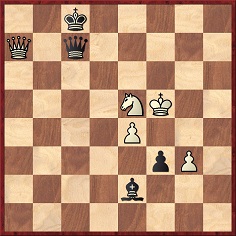
56 Qa8+ Qb8 57 Qxb8+ Kxb8 58 Ng4 Kc7 59 Kf4 Kd6 60 Ke3 Ke6 61 Nh2 Resigns.
Another game between the two players, at Purssell’s Coffee House:
Samuel Walter Earnshaw – Joseph Henry Blackburne
London (date?)
Three Knights’ Game
1 e4 e5 2 Nf3 Nc6 3 Nc3 g6 4 d4 exd4 5 Nxd4 Bg7 6 Be3 d6 7 Bb5 Ne7 8 O-O O-O 9 Nce2 f5 10 Bc4+ Kh8 11 Nf4 Nxd4 12 Bxd4 Nc6 13 Bxg7+ Kxg7 14 exf5 Rxf5 15 Qd2 Ne5 16 Ne6+ Bxe6 17 Bxe6 Rf6 18 Bb3 c6 19 h3 Qb6 20 Rae1 Raf8 21 Re3 a5 22 a4 Qc5 23 Rc3 Qb4 24 Qg5 b5 25 Ra1 Qd4 26 Qe3 Qxe3 27 fxe3 b4 28 Rd3 Nxd3 29 cxd3 Rf2 30 Bd1 Rxb2 31 Bf3 c5 32 Kf1 b3 33 Ra3 d5 34 Ke1
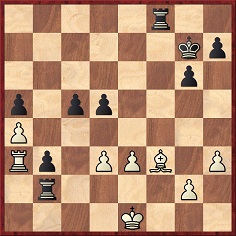
34...Rxf3 35 gxf3 c4 36 dxc4 dxc4 37 Kd1 Ra2 38 White resigns.
Source: Illustrated London News, 26 June 1880, page 631.
The Rev. Earnshaw’s obituary on pages 98-99 of the February 1888 BCM largely consisted of a quote from the Illustrated Sporting and Dramatic News. It stated, inter alia:
‘He was a great friend of Boden, and shortly before the latter’s decease Mr Earnshaw presented him with the board and men which Boden had used in his private encounters with Paul Morphy.’
That article about Earnshaw by G.A. MacDonnell was reproduced on pages 192-194 of MacDonnell’s book The Knights and Kings of Chess (London, 1894).
(9415)
As discussed on page 105 of our book about Capablanca, diverging opinions have been expressed on the quality of My Chess Career (London, 1920).
In his column ‘Half a Century Back. Chess in 1920’ W.H. Cozens wrote on page 354 of the December 1970 BCM:

That reference to Tarrasch’s autobiographical collection (published in 1894/95) came to mind when, earlier today, we opened the latest McFarland production, Joseph Henry Blackburne. A Chess Biography by Tim Harding. From page 1, after some critical remarks about Mr Blackburne’s Games at Chess:
‘To be fair to Blackburne, he was the first leading master to compile a book about his career, and in 1899 there was no template for how to do it.’
Harding’s book starts unfortunately (the first line of the first chapter, on page 7, is: ‘Joseph Henry Blackburne was born on 10 December at 1841’) and, it must be said, the work as a whole would have benefited from greater attention to certain C.N. material (e.g. C.N. 7324). Even so, any critic with the new Sánchez and Harding books before him should recognize at once the overwhelming superiority of the latter. We look forward to reading both volumes from cover to cover, but the Blackburne one will take precedence.
(9457)
C.N. 9457 observed regarding Joseph Henry Blackburne. A Chess Biography by Tim Harding (Jefferson, 2015) that ‘the work as a whole would have benefited from greater attention to certain C.N. material’. Page 111 of the book provides another example:
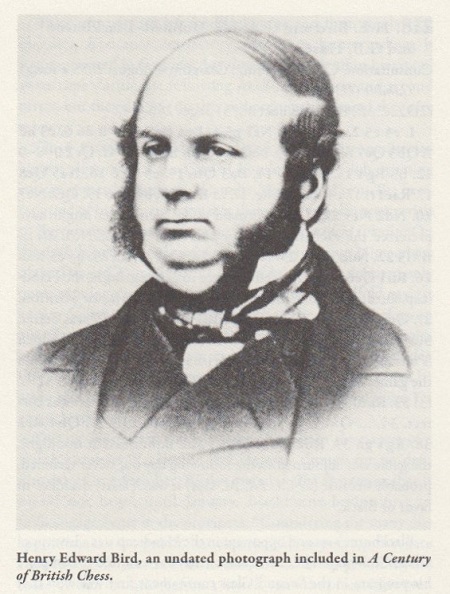
The picture shows not Henry Edward Bird but Henry Thomas Buckle, as was pointed out in C.N. 8346 in connection with page 29 of the hardback edition (1977) of Harry Golombek’s Encyclopedia of Chess.
(9526)
A reviewer whose own volumes are notorious for blunders and other defects (plagiarism, for instance) should be neither reviewing nor authoring. Nor, of course, should any writer wish to quote favourable opinions received from such a reviewer. T. Harding rushing to cite R. Keene’s fulsome praise of his Blackburne book was a pathetic spectacle.
(9592)
An entry in Chess Thoughts:
Praise received should be quoted sparingly, and never when from a disreputable source.
From Hype in Chess:
Fulsome praise has been heaped on the new Blackburne book by Tim Harding by Tim Harding.
Source: Chess Mail (website of Tim Harding).
See too Mistaken Identity. That feature article includes the following (C.N. 3239):
On page 117 of Historia general del ajedrez by Julio Ganzo (Madrid, 1973) a photograph of Blackburne was labelled ‘Chigorin’:
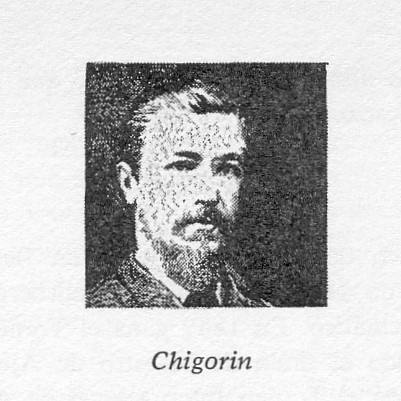
Olimpiu G. Urcan has sent us two photographs, taken in early 1894, of H.E. Bird, I. Gunsberg and J.H. Blackburne:
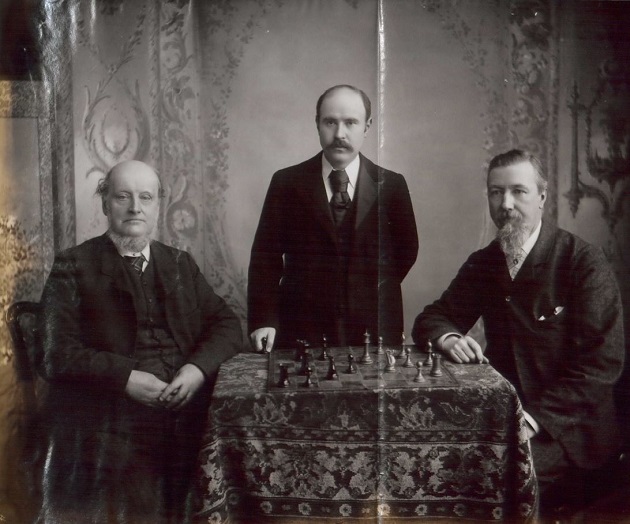
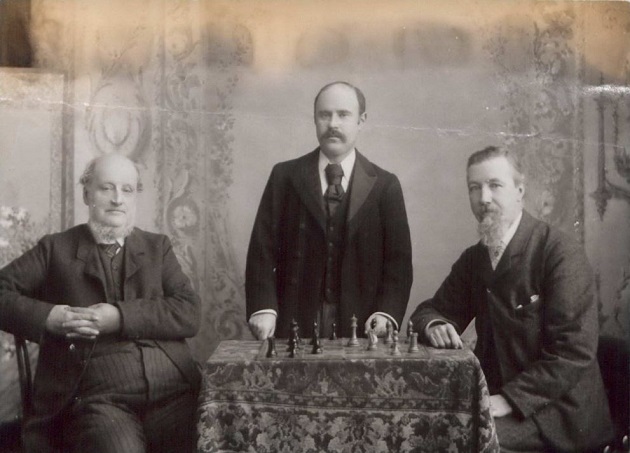
Our correspondent’s source is as specified in C.N. 9296, where forgotten portraits of Lasker and Blackburne were presented. The first shot of Bird, Gunsberg and Blackburne above was included, from a different source, on page 132 of Tim Harding’s fine book Eminent Victorian Chess Players (Jefferson, 2012).
(9527)

An uncreased copy of this photograph was published on page viii of Hastings 1895 by Colin Crouch and Kean Haines (Sheffield, 1995).
(10018)
A familiar consultation game played by F.W. Womersley, in partnership with Bird, was against Blackburne and Aloof (Hastings, 17 February 1897). Gerard Killoran (Ilkley, England) has sent us its appearance on page 6 of the Morning Post, 22 February 1897:
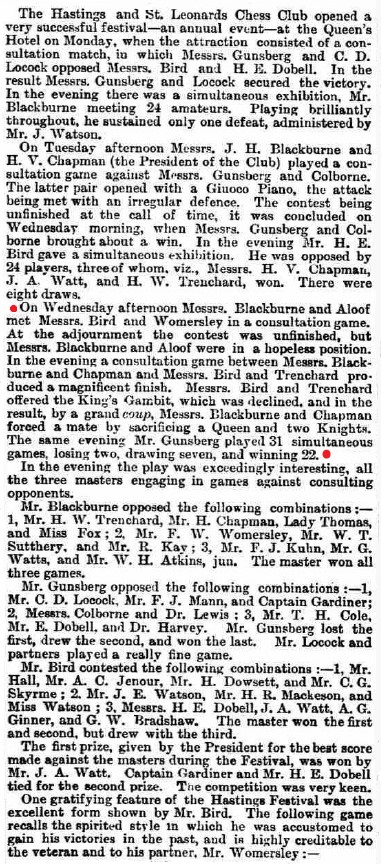
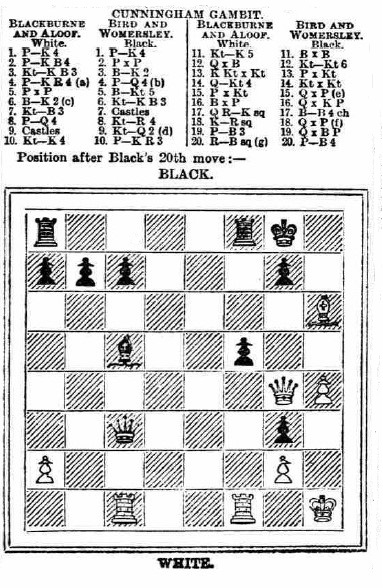
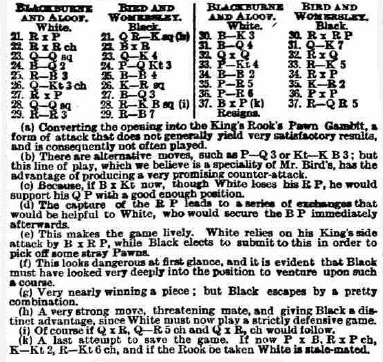
1 e4 e5 2 f4 exf4 3 Nf3 Be7 4 h4 d5 5 exd5 Bg4 6 Be2 Nf6 7 Nc3 O-O 8 d4 Nh5 9 O-O Nd7 10 Ne4 h6 11 Ne5 Bxe2 12 Qxe2 Ng3 13 Nxg3 fxg3 14 Qg4 Nxe5 15 dxe5 Qxd5 16 Bxh6 Qxe5 17 Rae1 Bc5+ 18 Kh1 Qxb2 19 c3 Qxc3 20 Rc1 f5 21 Rxf5 Rae8 22 Rxf8+ Bxf8 23 Qd1 Qe5 24 Bd2 b6 25 Rc3 Bc5 26 Qb3+ Kh8 27 Rxg3 Bd6 28 Qd1 Rf8 29 Rh3 Rf2 30 Be3 Rxa2 31 Bd4 Qe2 32 Qxe2 Rxe2 33 g4 Re4 34 Bf2 Rxg4 35 h5 Kh7 36 h6 gxh6
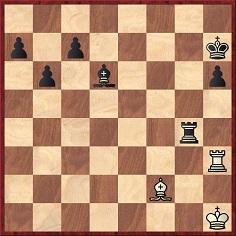
37 Bxb6 Ra4 38 White resigns.
Details of the Hastings Chess Festival programme were also related on pages 90-91 of the March 1897 BCM. Pages 91-92 had the Aloof and Blackburne v Bird and Womersley game, with notes by James Mason. (The conclusion was ‘34 B-B2 RxP. The game was continued some moves further and Black won.’)
In both the Morning Post and the BCM the opening moves were 1 e4 e5 2 f4 exf4 3 Nf3 Be7 4 h4, but page 365 of Joseph Henry Blackburne A Chess Biography by Tim Harding (Jefferson, 2015) stated that h4 was played on move three:
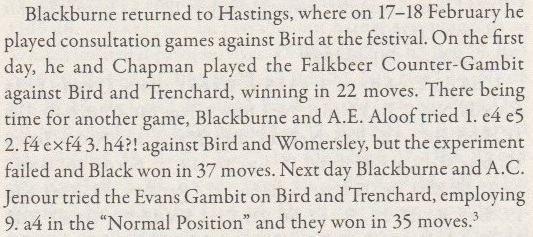
The Morning Post and the BCM reported that the game involving Womersley occurred first, and that the Falkbeer Counter-Gambit game was played in the evening.
The endnote on page 554 of Harding’s book:

An example of ‘London’ as the venue, instead of Hastings, is on page 265 of Unorthodox Chess Openings by Eric Schiller (New York, 1998), in a section about 1 e4 e5 2 f4 exf4 3 h4. Finally, Harding was incorrect to write that the game involving Blackburne and Womersley can be found in Mr Blackburne’s Games at Chess by P. Anderson Graham (London, 1899).
(9669)
From pages 225-226 of Chess Studies and End-Games by B. Horwitz and J. Kling (London, 1889):
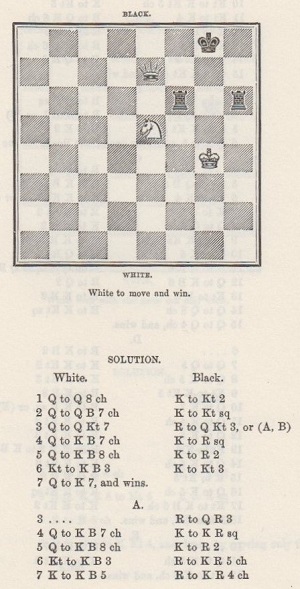
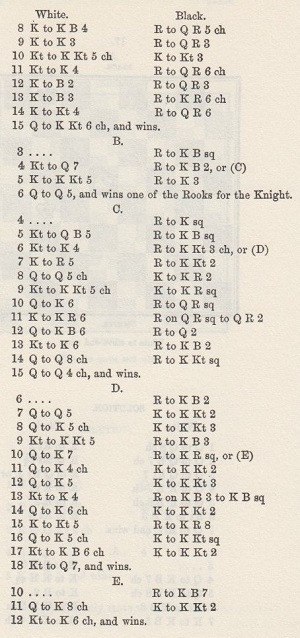
Without any particulars, page 193 of the May 1898 BCM queried whether the solution was conclusive. The position was discussed on page 304 of Traité des fins de partie d’échecs by Un Amateur de l’Ex. U.A.A.R. (Paris, 1924), which noted a correction by Blackburne:
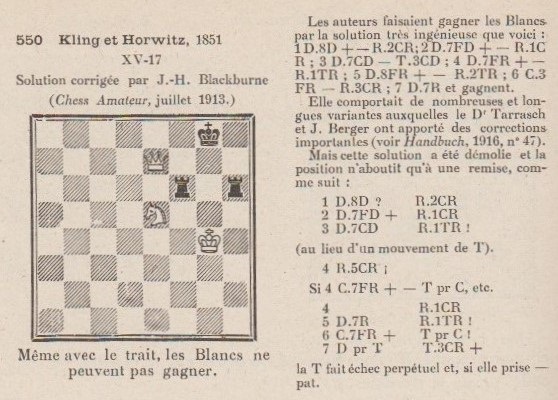
Below is the item in question, from E.E. Cunnington’s column on page 305 of the July 1913 Chess Amateur:
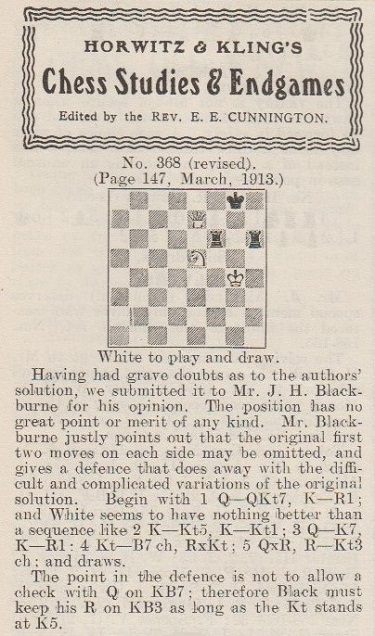
(9703)
Michael McDowell (Westcliff-on-sea, England) has sent us over 30 illustrations by Frederick Orrett (1858-1939), including this depiction of Blackburne (with, in the background, que instead of qui):
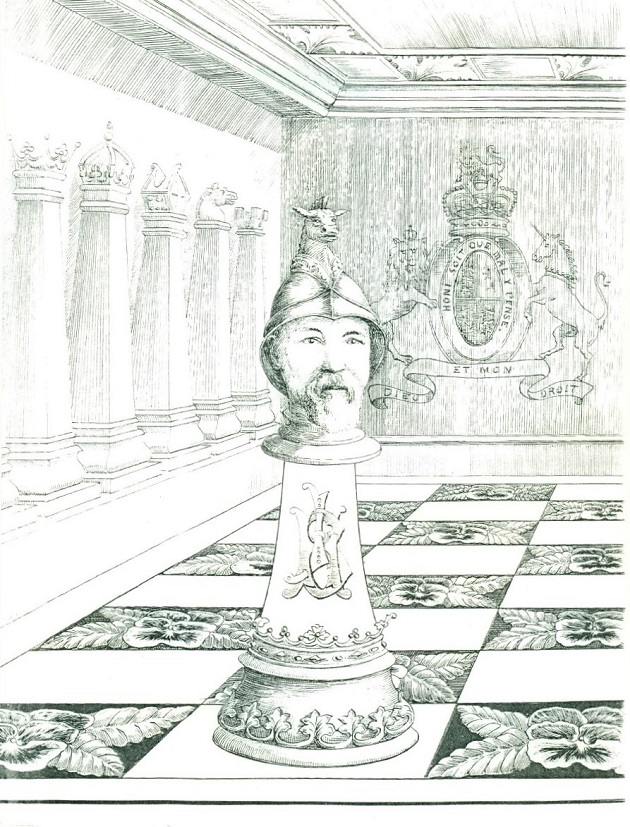
(9722)
Photographs inscribed by one master to another are scarce. Below is the frontispiece of an 1891 book by Andrés Clemente Vázquez:
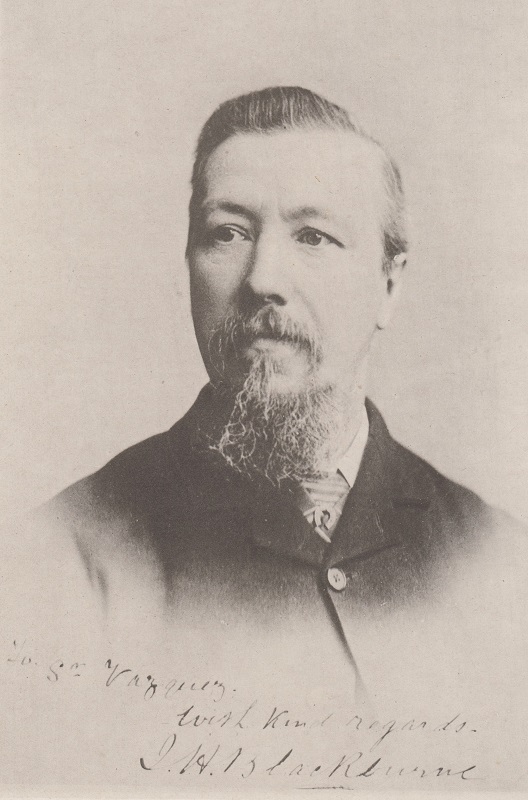
The photograph was reproduced on page 309 of Joseph Henry Blackburne. A Chess Biography by Tim Harding (Jefferson, 2015), but with the inscription chopped off.
Vázquez’s book shows the difficulties facing writers and bibliographers who seek precision. Surprisingly often, there is a disparity between a volume’s title on a) the front cover or dust-jacket and b) the title page. In such cases, we consider it preferable to use the latter, but the two may be entirely different:
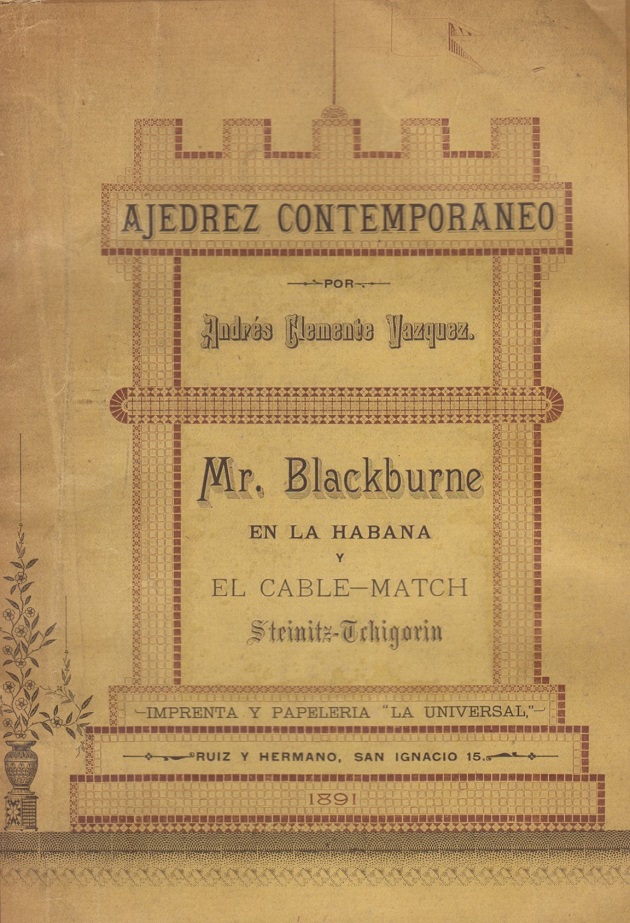
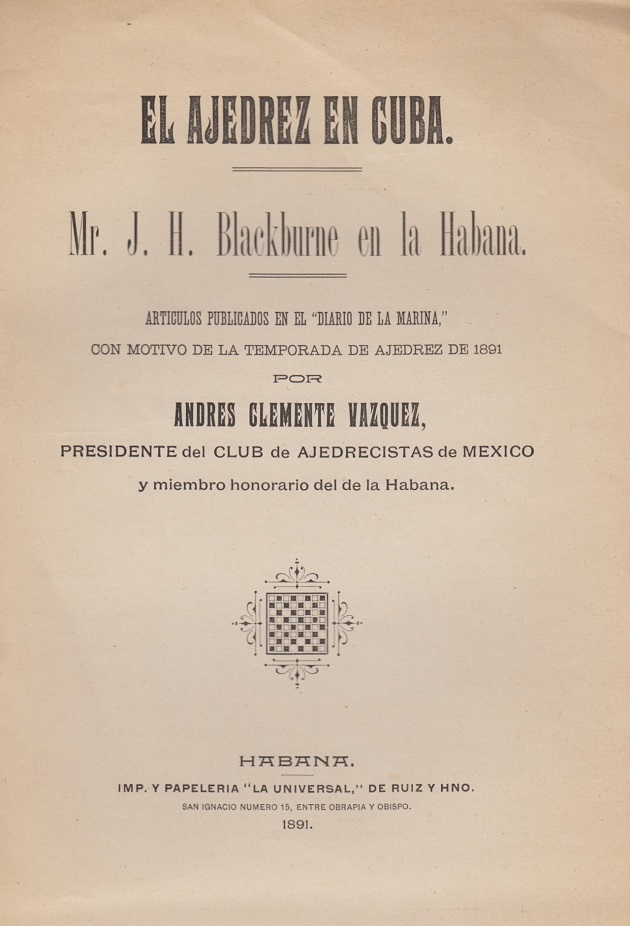
The remainder of this item, C.N. 9845, gave further information about A.C. Vázquez.
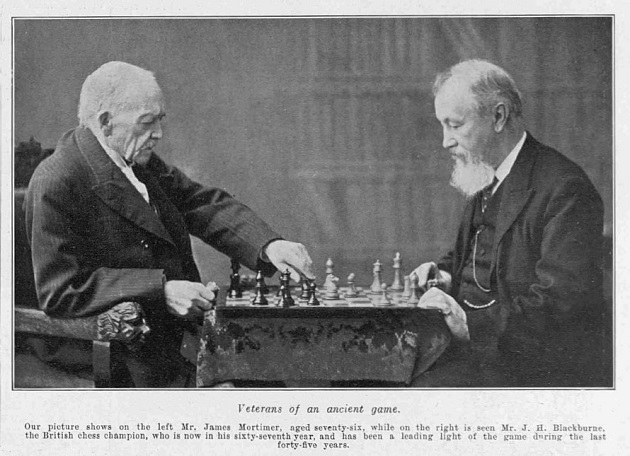
Illustrated Sporting and Dramatic News, 16 January 1909, page 799
(10307)
On page 164 of the Illustrated London News, 23 July 1955 B.H. Wood referred to ‘the “Mac-Lopez” – that deliciously-coined title for the variation of the Ruy Lopez which resembles the Scotch Game’.
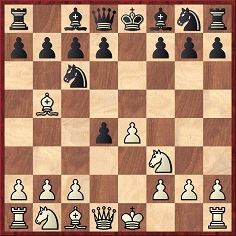
Position after 1 e4 e5 2 Nf3 Nc6 3 d4 exd4 4 Bb5
From page 167 of 500 Master Games of Chess by S. Tartakower and J. du Mont (London, 1952):
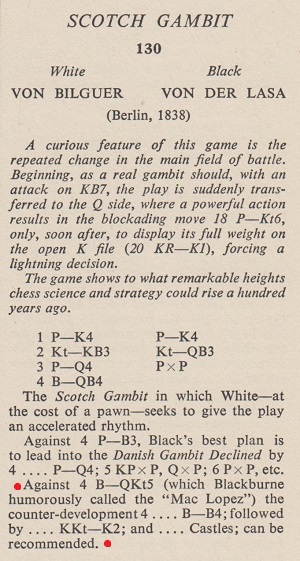
Blackburne mentioned his remark in a note after 4 Bb5 on page 443 of the November 1904 BCM (in a game against W.C. Palmer in the British Championship Tournament at Hastings, 1904):
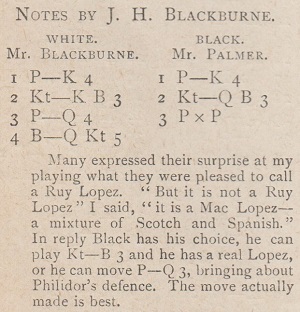
When the game was published on pages 359-360 of the Deutsche Schachzeitung, December 1904, reference was made to a game between Lange and Schierstädt (sic) in 1857 (sic):
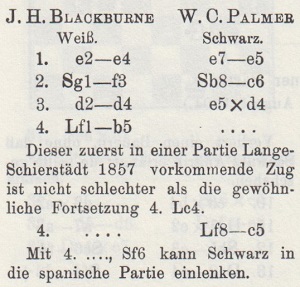
That well-known Max Lange brilliancy was included on, for instance, pages 10-12 of The King-Hunt by W.H. Cozens (London, 1970), where Black was identified as von Schierstedt and the heading was ‘Exhibition Game, about 1856’. Various anything-will-do databases state – categorically, of course – either 1856 or 1857, without any venue, but when Max Lange himself annotated the game on pages 112-115 of his book Sammlung Neuer Schachpartien (Leipzig, 1857) he gave Black’s name as Herr von Schierstedt, with the information ‘gespielt zu Wörmlitz am 1. März 1855’.
In connection with another familiar (capped knight) game, see C.N. 3502 for a reference to ‘Fräulein Jenny von Schierstedt’.
(10327)
Olimpiu G. Urcan sends an interview with J.H. Blackburne published on page 6 of the Derbyshire Advertiser and Journal, 2 December 1887:

The newspaper then gave a detailed report, without games, of Blackburne’s 28-board simultaneous display in Derby the previous week (24 November 1887).
(10395)
Wanted: a better version of this photograph, which was published in a very small format on page 393 of the October 1924 BCM:
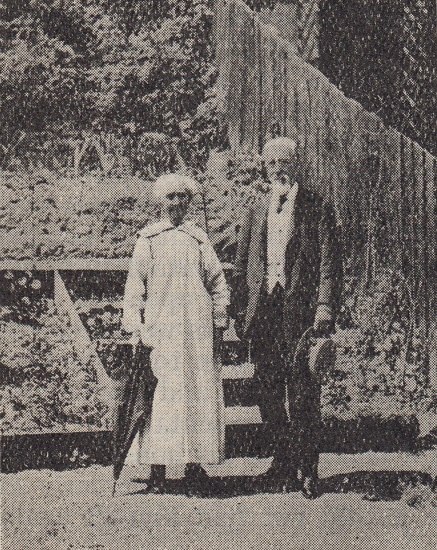
An obituary of J.H. Blackburne’s wife, née Mary Jane Fox, was on page 50 of the February 1922 BCM.
(10587)
Regarding What is a Chess Combination?, Jean-Pierre Rhéaume (Montreal, Canada) notes that Lasker’s Manual of Chess does not mention the word ‘sacrifice’ in the definition of a combination. From page 123 of the 1927 book and page 109 of the 1932 edition:
‘In the rare instances that the player can detect a variation or net of them which leads to a desirable issue by force, the totality of these variations and their logical connections, their structure, are named a “combination”. And he who follows in his play such a chain of moves is said to “make a combination”.’
We recall a position from Blackburne v Weiss, New York, 1 April 1889:
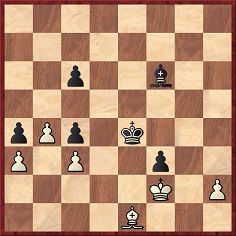
Black to move
52...Bh4+ 53 Kf1 Bxe1 54 Kxe1 Kd3 55 h4 Kxc3 56 h5 Kb3 57 h6 c3 58 h7 c2 59 Kd2 f2 60 h8(Q) c1(Q)+ 61 Kxc1 f1(Q)+ 62 Kd2 Qf2+ 63 Kd3 Qc2+ 64 Ke3 Qc3+ 65 Qxc3+ Kxc3 66 Ke4 Kb3 67 Kd4 Kxa3 68 Kc3 Ka2 69 Kc2 a3 70 Kc1 Kb3 71 White resigns.
On page 140 of The Most Instructive Games of Chess Ever Played (New York, 1965) Irving Chernev commented after 52...Bh4+:
‘This begins a 15-move combination. Despite its length, it is easy enough to visualize and understand it, if we break it down.’
Chernev then listed six stages in ‘the series of ideas’.
After 54...Kd3 Steinitz wrote on page 74 of the New York, 1889 tournament book:
‘The rest speaks for itself, for every move of the opponent is forced. Very likely, Herr Weiss had foreseen the present position and played for it some moves ago, before exchanging bishops, but, undoubtedly, he must have fore-calculated the very end of this game 16 moves later, when he did effect the exchange and relied on the move in the text.’
(10605)
In 1991 Dale Brandreth published a scrapbook – presented to the Hampstead Chess Club by R.C. Griffith in 1918 – comprising chess columns (1891-94) in the Hampstead & Highgate Express, as well as other unidentified newspapers. Page 10 had three games from page 6 of the Hampstead & Highgate Express, 9 December 1893:
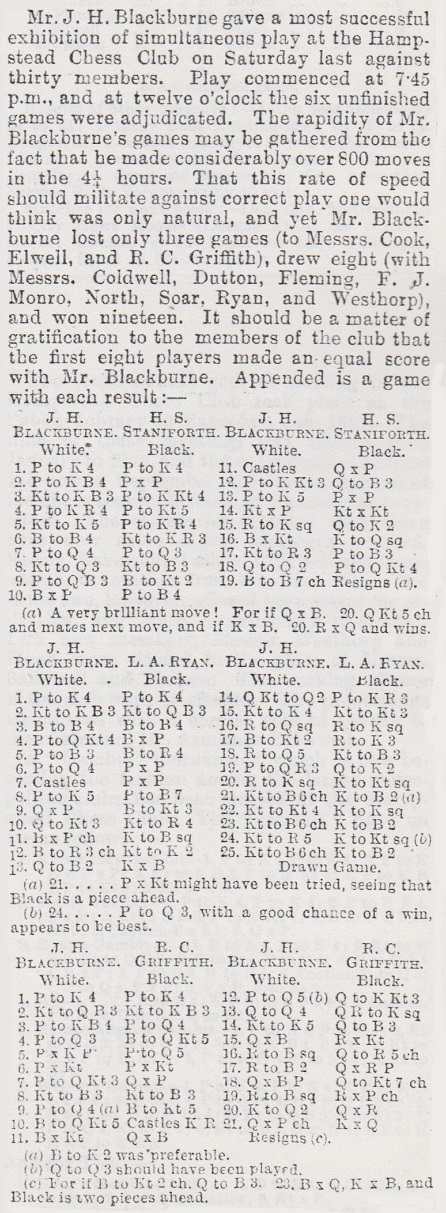
Joseph Henry Blackburne – H.S. Staniforth
Hampstead, 2 December 1893
King’s Gambit Accepted
1 e4 e5 2 f4 exf4 3 Nf3 g5 4 h4 g4 5 Ne5 h5 6 Bc4 Nh6 7 d4 d6 8 Nd3 Nc6 9 c3 Bg7 10 Bxf4 f5 11 O-O Qxh4 12 g3 Qf6 13 e5 dxe5 14 Nxe5 Nxe5 15 Re1 Qe7 16 Bxe5 Kd8 17 Na3 c6 18 Qd2 b5
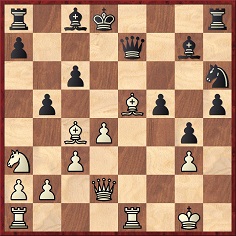
19 Bc7+ Resigns.
Joseph Henry Blackburne – L.A. Ryan
Hampstead, 2 December 1893
Evans Gambit Accepted
1 e4 e5 2 Nf3 Nc6 3 Bc4 Bc5 4 b4 Bxb4 5 c3 Ba5 6 d4 exd4 7 O-O dxc3 8 e5 c2 9 Qxc2 Bb6 10 Qb3 Na5 11 Bxf7+ Kf8 12 Ba3+ Ne7 13 Qc2 Kxf7 14 Nbd2 h6 15 Ne4 Ng6 16 Rfd1 Re8 17 Bb2 Re6 18 Rd5 Nc6 19 a3 Qe7 20 Re1 Kg8
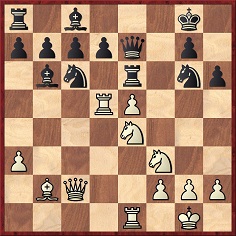
21 Nf6+ Kf7 22 Ng4 Ke8 23 Nf6+ Kf7 24 Nh5 Kg8 25 Nf6+ Kf7 Drawn.
Joseph Henry Blackburne – Richard Clewin Griffith
Hampstead, 2 December 1893
Vienna Gambit
1 e4 e5 2 Nc3 Nf6 3 f4 d5 4 d3 Bb4 5 fxe5 d4 6 exf6 dxc3 7 b3 Qxf6 8 Nf3 Nc6 9 d4 Bg4 10 Bb5 O-O 11 Bxc6 Qxc6 12 d5 Qg6 13 Qd4
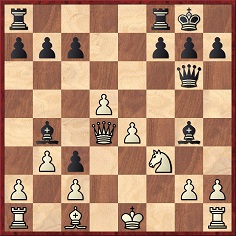
13...Rae8 14 Ne5 Qf6 15 Qxb4 Rxe5 16 Rf1 Qh4+ 17 Rf2 Qxh2 18 Qxc3 Qg1+ 19 Rf1 Rxe4+ 20 Kd2 Qxf1 21 Qxg7+ Kxg7 22 White resigns.
A game given sourcelessly on page 63 of the scrapbook:
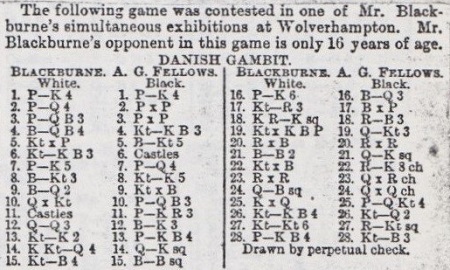
Morning Post, 26 November 1894, page 2
Joseph Henry Blackburne – Arthur G. Fellows
Wolverhampton (exact occasion and date?)
Danish Gambit
1 e4 e5 2 d4 exd4 3 c3 dxc3 4 Bc4 Nf6 5 Nxc3 Bb4 6 Nf3 O-O 7 e5 d5 8 Bb3 Ne4 9 Bd2 Nxd2 10 Qxd2 c6 11 O-O h6 12 Qd3 Be6 13 Ne2 f5 14 Nfd4 Qe8 15 Nf4 Bc8 16 e6 Bd6 17 Nh3 Bxe6 18 Rfe1 Rf6
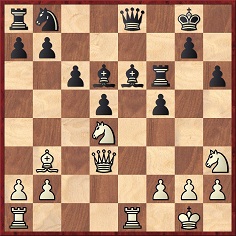
19 Nxf5 Qg6 20 Rxe6 Rxe6 21 Bc2 Qe8 22 Nxd6 Re1+ 23 Rxe1 Qxe1+ 24 Qf1 Qxf1+ 25 Kxf1 b5 26 Nf4 Nd7 27 Ng6 Rb8 28 f4 Nf6 Drawn.
Finally, page 81 of the scrapbook had this cutting from an unidentified source:
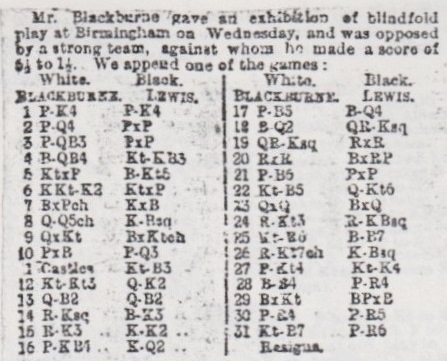
Joseph Henry Blackburne – C.F. Lewis
Birmingham, 18 October 1893
Danish Gambit
1 e4 e5 2 d4 exd4 3 c3 dxc3 4 Bc4 Nf6 5 Nxc3 Bb4 6 Ne2 Nxe4 7 Bxf7+ Kxf7 8 Qd5+ Kf8 9 Qxe4 Bxc3+ 10 bxc3 d6 11 O-O Nc6 12 Ng3 Qe7 13 Qc2 Qf7 14 Re1 Be6 15 Re3
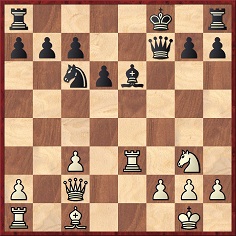
15...Ke7 16 f4 Kd7 17 f5 Bd5 18 Bd2 Rae8 19 Rae1 Rxe3 20 Rxe3 Bxa2 21 f6 gxf6 22 Nf5 Qb3 23 Qxb3 Bxb3 24 Rg3 Rf8 25 Nh6 Bc2 26 Rg7+ Kc8 27 g4 Ne5 28 Bf4 a5 29 Bxe5 fxe5 30 h4 a4 31 Nf7 a3 31 White resigns.
An account of Blackburne’s eight-board blindfold display in Birmingham was on page 5 of the Birmingham Daily Post, 19 October 1893:
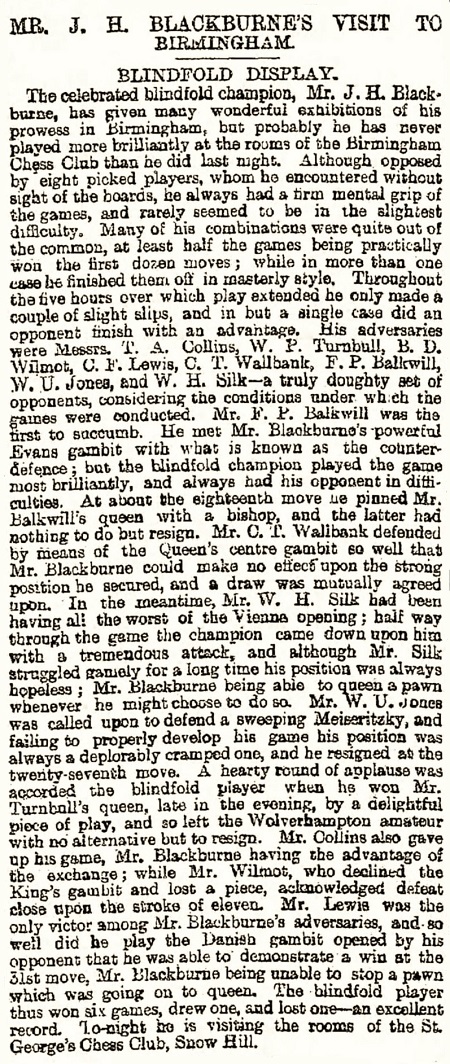
(10811)
On the subject of Blackburne and the Evans Gambit, below is a game from pages 44-45 of the January 1895 BCM:
Joseph Henry Blackburne – J.W. Robson
Newcastle, 14 November 1894
Evans Gambit Accepted
1 e4 e5 2 Nf3 Nc6 3 Bc4 Bc5 4 b4 Bxb4 5 c3 Ba5 6 d4 exd4 7 O-O dxc3 8 e5 d5 9 exd6 Qxd6 10 Qb3 Qg6 11 Ba3 Nge7 12 Nxc3 O-O 13 Rfe1 Re8 14 Ne5 Nxe5 15 Rxe5 Bh3 16 g3 Bxc3 17 Qxc3 Nc6 18 Rxe8+ Rxe8 19 Rd1 Qe4 20 Bd5
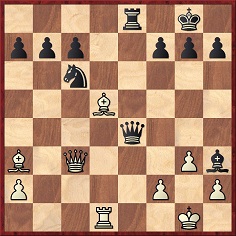
20...Nd4 21 Bxe4 Ne2+ 22 Kh1 Nxc3 23 Rc1 Rxe4 24 f3 Re3 25 White resigns.
The BCM gave the game with notes by G.C. Heywood in the Newcastle Weekly Chronicle. We do not have electronic access to the relevant edition of that newspaper, but page 61 of the R.C. Griffith scrapbook (C.N. 10811) has this unidentified cutting whose annotations match those in the BCM:
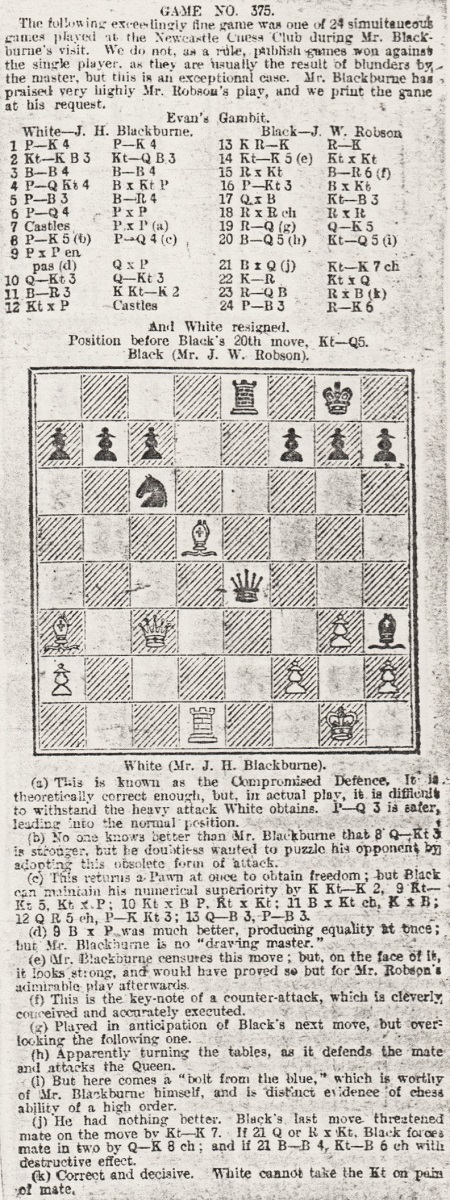
Page 496 of the December 1894 BCM gave the date of the 24-board display (+17 –2 =5) as 14 November 1894 and named two of the victors as J.W. Robson and G.H. Blunden. The latter’s win was published on page 2 of the Newcastle Courant, 1 December 1894: 1 e4 e6 2 d4 d5 3 Be3 c5 4 c3 cxd4 5 cxd4 Bb4+ 6 Nd2 Nf6 7 e5 Nfd7 8 f4 f6 9 Bd3 Nb6 10 Nf3 f5 11 O-O Bd7 12 Ng5 Be7 13 Ndf3 Nc6 14 Rc1 Nb4 15 Bb1 Nc4 16 Rxc4 dxc4 17 Re1 Nd5 18 Bd2 Qb6 19 Bc3 Nxf4 20 Kh1 h6 21 Nh3 Nxh3 22 gxh3 Bc6 23 Kg1 O-O-O 24 Nd2 Rxd4 25 Bxd4 Qxd4+ 26 Kf1 Bc5 27 Ne4 Qg1+ 28 Ke2 Qg2+ 29 Nf2 Qxf2 mate.
(10853)
Another simultaneous game played by J.H. Blackburne in Newcastle in November 1894 was given in C.N. 8294, from page 2 of the Newcastle Courant, 24 November 1894. It will be noted that the newspaper’s numbering of the moves was faulty:
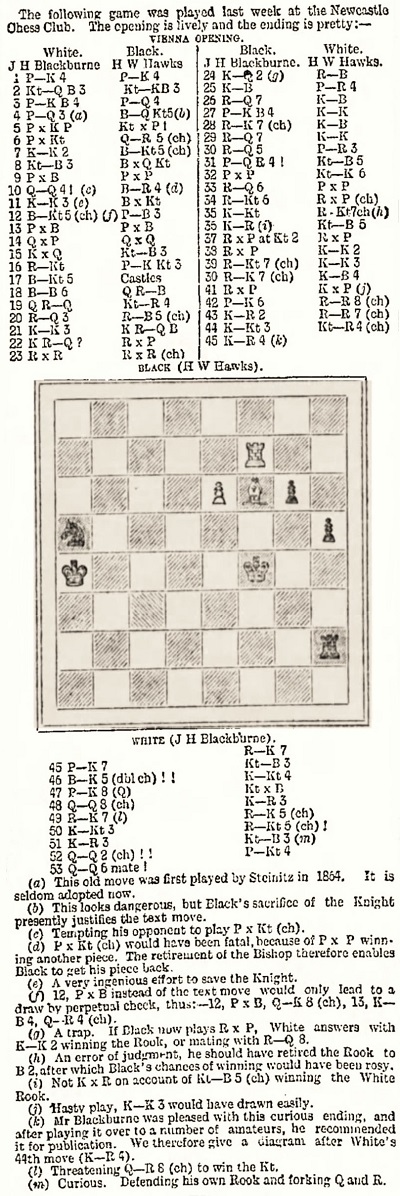
(10854)
From Olimpiu G. Urcan:
‘The Bodleian Library, Oxford holds the H.J.R. Murray Papers (MSS H.J. Murray 1-168), donated to the library in 1955, the year of Murray’s death. This valuable archival material includes a document by Murray which gives details of his chessplaying activities (MS H.J. Murray 73, folios 210-292). It comprises a five-page introduction by Murray and 95 of his games, played between 1893 and 1937. Most were against club-level amateurs, but he also had encounters with Blackburne and Atkins.’
Our correspondent plans to present a large selection of the games on his Patreon webpage (C.N. 10866) but has given us the two above-mentioned scores:
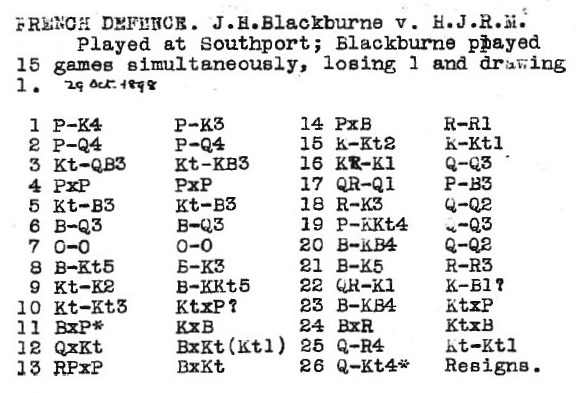
1 e4 e6 2 d4 d5 3 Nc3 Nf6 4 exd5 exd5 5 Nf3 Nc6 6 Bd3 Bd6 7 O-O O-O 8 Bg5 Be6 9 Ne2 Bg4 10 Ng3
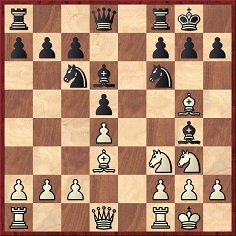
10...Nxd4 11 Bxh7+ Kxh7 12 Qxd4 Bxg3 13 hxg3 Bxf3 14 gxf3 Rh8 15 Kg2 Kg8 16 Rfe1 Qd6 17 Rad1 c6 18 Re3 Qd7 19 g4 Qd6 20 Bf4 Qd7 21 Be5 Rh6 22 Rde1 Kf8 23 Bf4 Nxg4 24 Bxh6 Nxh6 25 Qh4 Ng8 26 Qb4+ Resigns.
(10874)
Page 2 of the Newcastle Courant, 26 November 1898 had a pair of victories by Louis Zollner, against Bird and Blackburne, with the mere information ‘recently contested’:
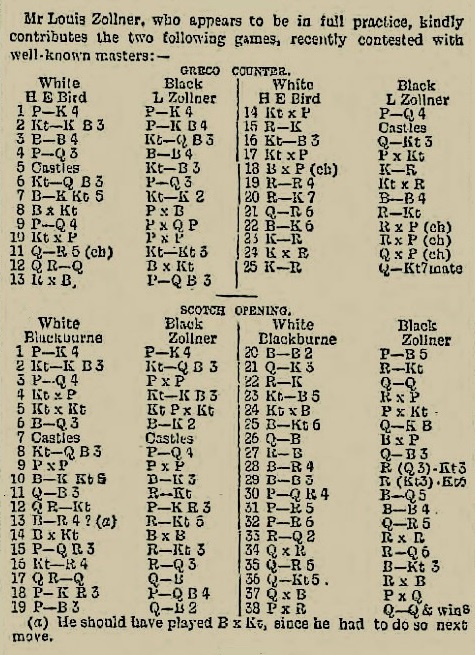
Bird v Zollner: 1 e4 e5 2 Nf3 f5 3 Bc4 Nc6 4 d3 Bc5 5 O-O Nf6 6 Nc3 d6 7 Bg5 Ne7 8 Bxf6 gxf6 9 d4 exd4 10 Nxd4 fxe4 11 Qh5+ Ng6 12 Rad1 Bxd4 13 Rxd4 c6 14 Nxe4 d5
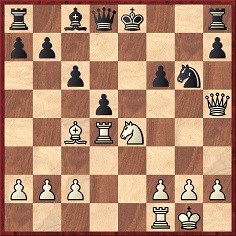
15 Re1 O-O 16 Nc3 Qb6 17 Nxd5 cxd5 18 Bxd5+ Kh8 19 Rh4 Nxh4 20 Re7 Bf5 21 Qh6
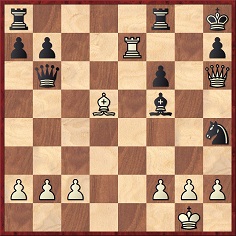
21...Rg8 22 Be6 Rxg2+ 23 Kh1 Rxh2+ 24 Kxh2 Qxf2+ 25 Kh1 Qg2 mate.
Blackburne v Zollner: 1 e4 e5 2 Nf3 Nc6 3 d4 exd4 4 Nxd4 Nf6 5 Nxc6 bxc6 6 Bd3 Be7 7 O-O O-O 8 Nc3 d5 9 exd5 cxd5 10 Bg5 Be6 11 Qf3 Rb8 12 Rab1 h6 13 Bh4 Rb4 14 Bxf6 Bxf6 15 a3 Rb6 16 Na4 Rd6 17 Rbd1 Qc8 18 h3 c5 19 c3 Qc7 20 Bc2 c4 21 Qe3 Rb8 22 Rfe1 Qd8 23 Nc5 Rxb2 24 Nxe6 fxe6 25 Bg6 Qf8 26 Qc1 Bxc3 27 Rf1 Qf6 28 Bh5 Rdb6 29 Bf3
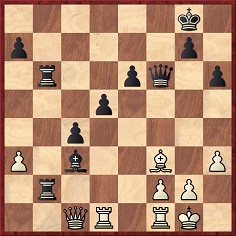
29...R6b3 30 a4 Bd4 31 a5 Bc5 32 a6 Qh4 33 Rd2 Rxd2 34 Qxd2 Rd3 35 Qa5 Bb6 36 Qb5
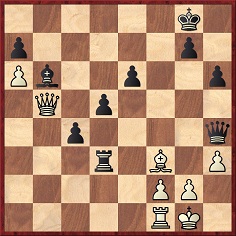
36...Rxf3 37 Qxb6 axb6 38 gxf3 Qd8 39 White resigns.
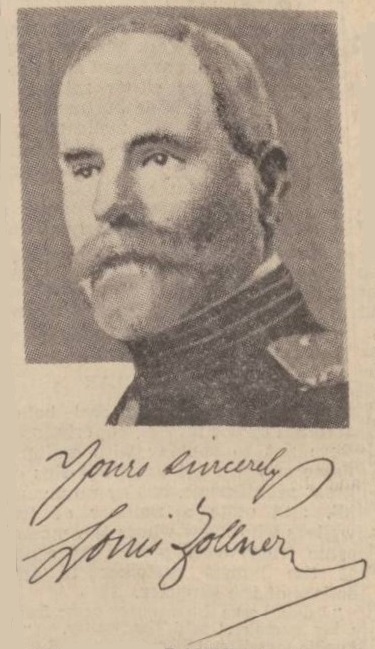
Newcastle Evening Chronicle, 17 April 1939, page 10.
(10877)
From the first volume (1898-99) of Alapin’s periodical Der Schachfreund (frontispiece):
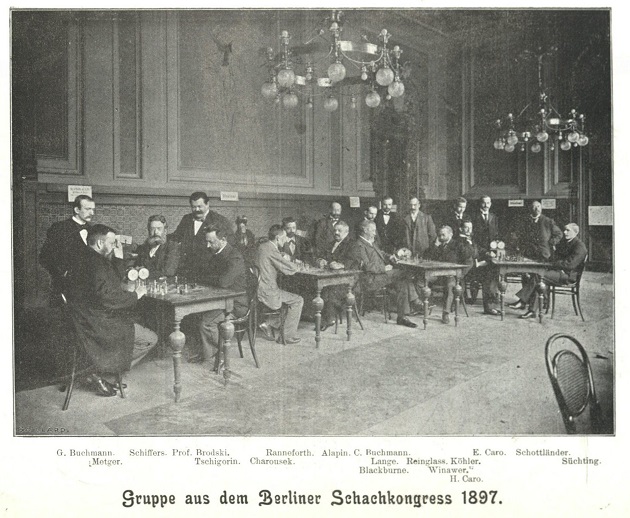
The high-resolution scan is shown here courtesy of the Cleveland Public Library.
(11439)
Below is an image received from Yuri Kireev and Mikhail Sokolov (Moscow) as part of a discussion about the prodigy Prince Gedroiz/Gedroits:
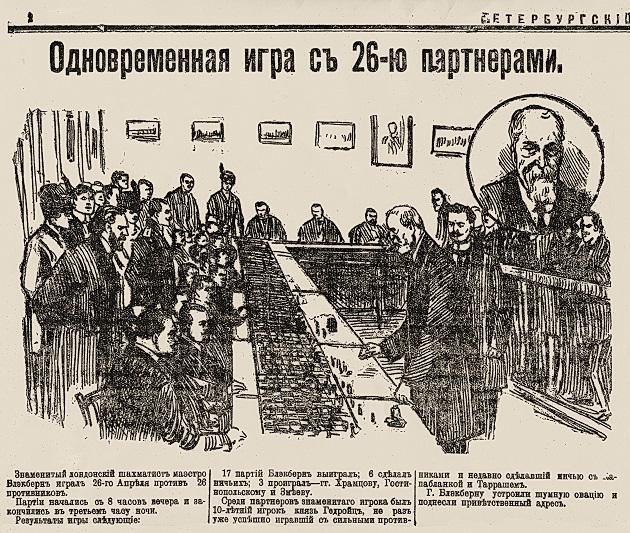
Source: Peterburgsky Listok, 28 April 1914, page 2.
It is a sketch of Blackburne’s 26-board display in St Petersburg on 26 April/9 May 1914. The caption gives the score as +17 –3 =6 and names the victors, but it does not specify Gedroiz’s result. There was no report on this exhibition in Shakhmatny Vestnik. Page 178 of Deutsches Wochenschach, 17 May 1914 and page 187 of the June 1914 Deutsche Schachzeitung gave the score as +17 –2 =7.
(11457)
A game won by J.H. Blackburne against a player named Daly was published on pages 5-6 of the Household Chess Magazine, 31 January 1865:
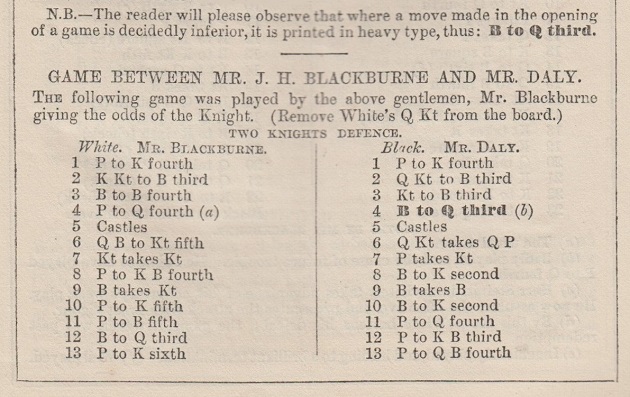
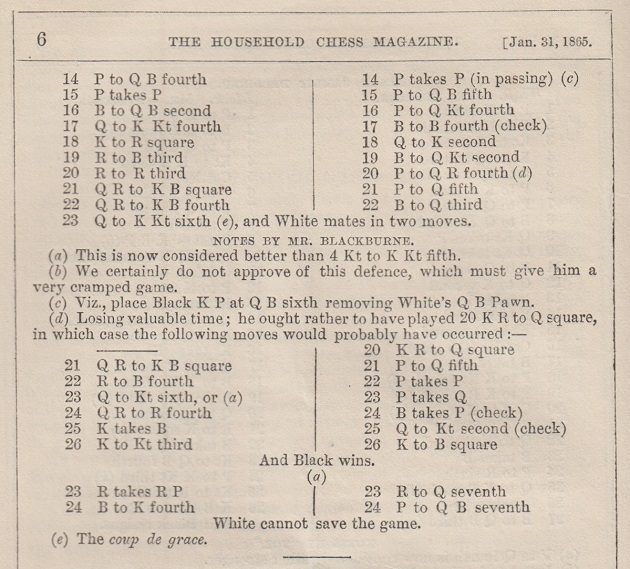
(Remove White’s queen’s knight.) 1 e4 e5 2 Nf3 Nc6 3 Bc4 Nf6 4 d4 Bd6 5 O-O O-O 6 Bg5 Nxd4 7 Nxd4 exd4 8 f4 Be7 9 Bxf6 Bxf6 10 e5 Be7 11 f5 d5 12 Bd3 f6 13 e6 c5 14 c4 dxc3 15 bxc3 c4 16 Bc2 b5 17 Qg4 Bc5+ 18 Kh1 Qe7 19 Rf3 Bb7 20 Rh3 a5 21 Rf1 d4 22 Rf4 Bd6
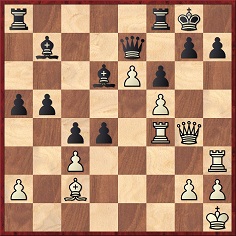
23 Qg6 ‘and White mates in two moves’.
(11651)
See too:
A consultation game in Chessplayer Shot in Hastings, our feature article of F.W. Womersley;
To the Chess Notes main page.
To the Archives for other feature articles.
Copyright: Edward Winter. All rights reserved.